Audited financial statements for NLB d.d.
Notes to financial statements

Notes to financial statements
1. GENERAL INFORMATION
Nova Ljubljanska banka d.d., Ljubljana ("the Bank" or "NLB") is incorporated in Slovenia as a joint stock company providing universal banking services. The largest shareholders of Nova Ljubljanska banka d.d. are the Republic of Slovenia, owning 33.10% of the shares, and KBC Bank N.V., Brussels ("KBC Bank"), owning 30.57% of the shares.
The address of its registered office is: Nova Ljubljanska banka d.d., Ljubljana, Trg republike 2, Ljubljana.
All amounts in the financial statements and in the notes to the financial statements are expressed in thousands of euros unless otherwise specified.
2. SUMMARY OF SIGNIFICANT ACCOUNTING POLICIES
The principal accounting policies adopted for the preparation of the financial statements are set out below:
2.1. Statement of compliance
The financial statements have been prepared in accordance with International Financial Reporting Standards (IFRS) as adopted by the European Union (EU).
Separate financial statements of the Bank have been prepared in addition to consolidated financial statements according to the requirements of local legislation.
The Bank has also prepared consolidated financial statements in accordance with IFRS as adopted by the EU for the Bank and its subsidiaries (the Group). In the consolidated financial statements, subsidiary undertakings, which are those companies in which the Group, directly or indirectly, has an interest of more than half of the voting rights or otherwise has the power to exercise control over the operations, have been fully consolidated. The consolidated financial statements can be obtained from the Bank’s registered office.
Users of these stand alone financial statements should read them together with the Group’s consolidated financial statements as at and for the year ended 31 December 2009 in order to obtain full information on the financial position, results of operations and changes in financial position of the Group as a whole.
2.2. Basis of preparation of financial statements
The financial statements have been prepared under the historical cost convention as modified by the revaluation of available for sale financial assets, financial assets and financial liabilities at fair value through profit or loss, including all derivative contracts and investment property.
The preparation of financial statements in conformity with IFRS requires the use of estimates and assumptions that affect the reported amounts of assets and liabilities and disclosure of contingent assets and liabilities at the date of the financial statements and the reported amounts of revenues and expenses during the reporting period. Although these estimates are based on management’s best knowledge of current events and actions, actual results may ultimately differ from those estimates. Accounting estimates and underlying assumptions are reviewed on an ongoing basis. Revisions of accounting estimates are recognized in the period in which the estimate is revised Critical accounting estimates are disclosed in note 2.26.
The principal accounting policies applied in the preparation of these financial statements are set out below. These policies have been consistently applied to all the years presented.
2.3. Foreign currency translation
Functional and presentation currency
Items included in the financial statements are measured
using the currency of the primary economic environment
in which the Bank operates. The financial statements are
presented in euros, which is the Bank’s functional and
presentation currency.
Transactions and balances
Foreign currency transactions are translated into
functional currency at the exchange rates prevailing at
the dates of the transactions. Foreign exchange gains and
losses resulting from the settlement of such transactions
and from the translation of monetary assets and liabilities
denominated in foreign currencies are recognized in the
income statement, except when deferred in other
comprehensive income as qualifying cash flow hedges.
Translation differences resulting from changes in the amortized cost of monetary items denominated in foreign currency and classified as available for sale financial assets, are recognized in profit or loss.
Translation differences on non-monetary items, such as equities at fair value through profit or loss, are reported as part of the fair value gain or loss in the income statement. Translation differences on non-monetary items, such as equities classified as available for sale, are included in the revaluation reserve in other comprehensive income.
Gains and losses resulting from foreign currency purchases and sales for trading purposes are included in the income statement as gains less losses from financial assets and liabilities held for trading.
2.4. Interest income and expense
Interest income and expense are recognized in the income statement for all interest-bearing instruments on an accruals basis using the effective yield method. The effective interest rate method is a method of calculating the amortized cost of a financial asset or financial liability and of allocating the interest income or interest expense over the relevant period. The effective interest rate is the rate that exactly discounts estimated future cash payments or receipts through the expected life of the financial instrument or when appropriate, a shorter period to the net carrying amount of the financial asset or financial liability. Interest income includes coupons earned on fixed income investment and trading securities, accrued discounts and premiums on securities and interest from interest rate swaps. The calculation of effective interest rate includes all fees and points paid or received between parties to the contract and all transaction costs but does not consider future credit losses. Once a financial asset or a group of similar financial assets has been written down as a result of an impairment loss, interest income is recognized using the rate of interest used to discount the future cash flows for the purpose of measuring the impairment loss.
Interest income and expense from all financial assets and liabilities are disclosed as part of net interest income.
2.5. Fee and commission
Fees and commissions are generally recognized when the service has been provided. Fees and commissions consist mainly of fees received from payment services and from the managing of funds on behalf of legal entities and individuals, together with commissions from guarantees. Fees and commissions that are integral to the effective interest rate of financial assets and liabilities are presented within interest income or expense.
2.6. Dividend income
Dividends are recognized in the income statement when the Bank’s right to receive payment is established.
2.7. Financial instruments
a) Classification
Classification of financial instruments at initial recognition depends on instrument's characteristics and management intention. In general a bank follows the next criteria:
Financial instruments at fair value through profit or loss
This category has two sub-categories: financial
instruments held for trading and financial instruments
designated at fair value through profit or loss at
inception. A financial instrument is classified in this group
if acquired principally for the purpose of selling in the
short term or if so designated by management.
Derivatives are also categorized as held for trading unless they are designated as hedging instruments.
The Bank designates a financial instrument as at fair value through profit or loss when:
- It eliminates or significantly reduces a measurement or recognition inconsistency that would otherwise arise from measuring assets or liabilities on different basis or
- A group of financial assets, financial liabilities or both is managed and its performance is evaluated on fair value basis, in accordance with documented risk management or investment strategy, and information about the group is provided internally on that basis to the Bank’s key management or
- A financial instrument contains one or more embedded derivatives that can significantly modify the cash flows otherwise required by the contract.
Loans and receivables
Loans and receivables are non-derivative financial
instruments with fixed or determinable payments that are
not quoted in an active market, other than: (a) those that
the Bank intends to sell immediately or in the short term,
which are classified as held for trading, and those that
the Bank upon initial recognition designates as at fair
value through profit or loss; (b) those that the Bank upon
initial recognition designates as available for sale; or (c)
those for which the Bank may not recover substantially all
of its initial investment, other than because of credit
deterioration.
Held to maturity investments
Held to maturity investments are non-derivative financial
instruments with fixed or determinable payments and
fixed maturity that the Bank has the positive intention
and ability to hold to maturity.
Available for sale financial assets
Available for sale financial assets are those intended to be
held for an indefinite period of time, which may be sold
in response to needs for liquidity or changes in interest
rates, exchange rates or equity prices.
b) Measurement and recognition
Financial assets are initially recognized at fair value plus transaction costs for all financial assets not carried at fair value through profit or loss.
Financial assets carried at fair value through profit and loss are initially recognized at fair value, and transaction costs are expensed in the income statement.
Regular way purchases and sales of financial instruments at fair value through profit or loss, held to maturity and available for sale, are recognized on trade date. Loans are recognized when cash is advanced to the borrowers. All other purchases and sales are recognized as derivative forward transactions until settlement.
Financial assets at fair value through profit or loss and financial assets available for sale are subsequently measured at fair value. Gains and losses from changes in the fair value of the financial assets at fair value through profit or loss are included in the income statement in the period in which they arise. Gains and losses from changes in the fair value of available for sale financial assets are recognized in other comprehensive income until the financial asset is derecognized or impaired, at which time the effect previously included in other comprehensive income is recognized in the income statement. However, interest calculated using the effective interest method and foreign currency gains and losses on monetary assets classified as available for sale are recognized in the income statement. Dividends on available for sale equity instruments are recognized in the income statement when the Bank’s right to receive payment is established.
Loans and held to maturity investments are carried at amortized cost.
c) Day one profit
The best evidence of fair value at initial recognition is the transaction price (that is, the fair value of the consideration given or received), unless the fair value of that instrument is evidenced by comparison with other observable current market transactions in the same instrument (that is, without modification or repackaging) or based on a valuation technique whose variables include only data from observable markets.
Where the transaction price in a non-active market is different to the fair value from other observable current market transactions in the same instrument or is based on a valuation technique whose variable include only data from observable markets, the Bank recognizes the difference between the transaction price and fair value in the income statement (day one profit or loss). In cases where the data used for valuation is not “fully marketable” day one profits are not recognized.
The timing of recognition of deferred day one profit and loss is determined individually. It is either amortised over the life of transaction, deferred until the instrument’s fair value can be determined using market observable inputs, or realised through settlement.
d) Reclassification
Financial assets that are eligible for classification as loans and receivables can be reclassified out of held for trading category if they are no longer held for the purpose of selling or repurchasing them in the near term. Financial assets that are not eligible for classification as loans and receivables, may be transferred from held for trading category only in rare circumstances. Additionally instruments designated at fair value trough profit and loss and instruments held to maturity cannot be reclassified.
e) Derecognition
A financial asset is derecognized when the contractual rights to the cash flows from the financial asset expire or the financial asset is transferred and transfer qualifies for derecognition. A financial liability is derecognized only when it is extinguished - i.e. when the obligation specified in the contract is discharged, cancelled or expires.
f) Fair value measurement principles
The fair value of quoted financial instruments in active markets is based on current bid price at the balance sheet date excluding transaction costs. If there is no active market, the fair value of the instruments is estimated using discounted cash flow techniques or pricing models.
Where discounted cash flow techniques are used, estimated future cash flows are based on the management’s best estimates and the discount rate is a market-related rate at the balance sheet date for an instrument with similar terms and conditions. Where pricing models are used, inputs are based on market related measures at the balance sheet date.
g) Derivative financial instruments and hedge accounting
Derivative financial instruments, including forward and futures contracts, swaps and options, are initially recognized on the balance sheet at fair value. Derivative financial instruments are subsequently remeasured at their fair value. Fair values are obtained from quoted market prices, discounted cash flow models or pricing models, as appropriate. All derivatives are carried at their fair value within assets when favorable to the Bank, and within liabilities when unfavorable to the Bank. Changes in fair value are determined on a clean price basis. Interest accruals are recorded separately from fair value measurement.
The method of recognizing the resulting fair value gain or loss depends on whether the derivative is designated as a hedging instrument, and if so, the nature of the item being hedged. The Bank designates certain derivatives as either:
- Hedges of the fair value of recognized assets or liabilities or firm commitments (fair value hedge) or
- Hedges of highly probable future cash flows attributable to a recognized asset or liability, or a forecasted transaction (cash flow hedge).
Hedge accounting is used for derivatives designated in this way provided certain criteria are met.
The Bank documents, at the inception of the transaction, the relationship between hedged items and hedging instruments, as well as its risk management objective and strategy for undertaking various hedge transactions. The Bank also documents its assessment, both at hedge inception and on an ongoing basis, of whether the derivatives that are used in hedging transactions are highly effective in offsetting changes in fair values or cash flows of hedged items. Actual results of the hedge must always fall within a range of 80 – 125 percent.
Fair value hedge
Changes in the fair value of derivatives that are
designated and qualify as fair value hedges are
recognized in the income statement, together with any
changes in the fair value of the hedged asset or liability
that are attributable to the hedged risk. Effective changes
in fair value of hedging instruments and related hedged
items are reflected in “fair value adjustments in hedge
accounting”. Any ineffectiveness is recorded in “Gains
less losses on financial assets and liabilities held for
trading”.
If the hedge no longer meets the criteria for hedge accounting, the adjustment to the carrying amount of a hedged item for which the effective interest method is used is amortized to profit or loss over the period to maturity and recorded as net interest income. The adjustment to the carrying amount of a hedged equity security is included in the income statement when the equity security is disposed of as part of the gain or loss on the sale.
Cash flow hedge
The effective portion of changes in the fair value of
derivatives that are designated and qualify as cash flow
hedges is recognized in other comprehensive income. The
gain or loss relating to the ineffective portion is recognized
immediately in the income statement – “Gains less losses
on financial assets and liabilities held for trading”.
Amounts accumulated in equity are recognized in the income statement in the periods when the hedged item affects profit or loss.
When a hedging instrument expires or is sold, or when a hedge no longer meets the criteria for hedge accounting, any cumulative gain or loss existing in other comprehensive income at that time remains in other comprehensive income and is recognized when the forecasted transaction is ultimately recognized in the income statement. When a forecasted transaction is no longer expected to occur, the cumulative gain or loss that was reported in other comprehensive income is immediately transferred to the income statement.
Derivatives that do not qualify for hedge accounting
Certain derivative instruments do not qualify for hedge
accounting. Changes in the fair value of such derivative
instruments are recognized immediately in the income
statement within ”Gains less losses on financial assets
and liabilities held for trading”.
2.8. Impairment of financial assets
a) Assets carried at amortized cost
On each reporting date the Bank assesses whether there is objective evidence that a financial asset or group of financial assets is impaired. A financial asset or group of financial assets is impaired and impairment losses are incurred if, and only if, there is objective evidence of impairment as a result of one or more events that occurred after the initial recognition of the asset and that event has an impact on the future cash flows of the financial asset or group of financial assets that can be reliably estimated.
The criteria that the Bank uses to determine that there is objective evidence of an impairment loss include:
- Delinquency in contractual payments of principal or interest,
- Cash flow difficulties experienced by the borrower,
- Breach of loan covenants or conditions,
- Initiation of bankruptcy proceedings,
- Deterioration of the borrower’s competitive position,
- Deterioration in the value of collateral and
- Downgrading below investment grade level.
The estimated period between a loss occurring and its identification is determined by management for each identified portfolio. In general, the periods used vary between three and six months.
If there is objective evidence that an impairment loss on loans and receivables or held to maturity investment has been incurred, the amount of the loss is measured as the difference between the asset’s carrying amount and the present value of estimated future cash flows discounted at the financial asset’s original effective interest rate. The carrying amount of the asset is reduced through an allowance account and the amount of the loss is recognized in the income statement. If a loan or held to maturity investment has a variable interest rate, the discount rate for measuring any impairment loss is the current effective interest rate determined under the contract.
Calculating the present value of the estimated future cash flows of collateralized financial assets reflects the cash flows that may result from foreclosure, less the cost of obtaining and selling the collateral, whether or not foreclosure is probable.
To collectively evaluate impairment, the Bank uses migration matrices, which show expected migration of customers between internal rating classes. The probability of migration is assessed on the basis of past years’ experience, that is annual migration matrices for different types of customers. Exposures to individuals are additionally analyzed with regard to type of products. Based on the migration matrices and assessment of average repayment rate for D and E rated customers, the Bank recognizes impairment losses also for clients that currently show no signs of impairment, but on the basis of past experience the Bank justifiably estimates that some losses have already incurred.
If the amount of the impairment subsequently decreases due to an event occurring after the write down, the reversal of loss is recognized as a reduction of an allowance for loan impairment.
When a loan is uncollectible, it is written off against the related allowance for loan impairment. Such loans are written off after all the necessary procedures have been completed and the amount of the loss has been determined. Subsequent recoveries of amounts previously written off decrease the amount of the provision for loan impairment in the income statement.
Objective criteria that the Bank uses to determine that a loan should be written off include:
- The debtor no longer performs his regular activities (termination of the legal entity),
- The Bank holds no adequate collateral to be used for repayment and
- Judicial recovery proceeding have concluded
b) Assets classified as available for sale
The Bank assesses at each reporting date whether there is objective evidence that financial assets available for sale are impaired. In the case of equity investments classified as available for sale, a significant or prolonged decline in the fair value of security below its cost is considered in determining whether the assets are impaired. If any such evidence exists for available for sale financial assets, the cumulative loss is removed from equity and recognized in the income statement as an impairment loss. Impairment losses recognized in the income statement on equity instruments are not reversed through the income statement; subsequent increases in their fair value after impairment are recognized in other comprehensive income.
If, in a subsequent period, the fair value of a debt instrument classified as available for sale increases and the increase can be objectively related to an event occurring after the impairment loss was recognized, the impairment loss is reversed through the income statement.
Bank considers the following factors in determining impairment losses on debt instruments:
- Default or delinquency in interest or principle payments,
- Liquidity difficulties of the issuer,
- Breach of contract covenants or conditions,
- Bankruptcy of the issuer,
- Deterioration of economic and market conditions and
- Deterioration in the credit rating of the issuer (bellow the acceptable level).
Impairment losses recognized in the income statement are measured as the difference between the carrying amount of the financial asset and its current fair value. Current fair value of the instrument is represented by its market price or discounted future cash flows, when the market price is not obtainable.
c) Renegotiated loans
Loans that are either subject to collective impairment assessment or individually significant and whose terms have been renegotiated due to deterioration of the borrower’s financial position are no longer considered to be past due but are treated as new loans. Such loans continue to be discounted using the original effective interest rate. In subsequent years, the asset is considered to be past due and disclosed only if renegotiated.
d) Repossessed property
In certain circumstances, property is repossessed following the foreclosure on loans that are in default. Repossessed properties are initially recognized in the financial statements at their fair values and are sold as soon as practicable in order to reduce outstanding indebtedness (note 6.1.i). After initial recognition they are measured at fair value.
2.9. Offsetting
Financial assets and liabilities are offset and the net amount reported in the statement of financial position when there is a legally enforceable right to set off the recognized amounts and there is an intention to settle on a net basis, or to realize the asset and settle the liability simultaneously.
2.10. Sale and repurchase agreements
Securities sold under sale and repurchase agreements (repos) are retained in the financial statements and the counterparty liability is included in financial liabilities associated to the transferred assets. Securities sold subject to sale and repurchase agreements are reclassified in the financial statements as pledged assets when the transferee has the right by contract or custom to sell or repledge the collateral. Securities purchased under agreements to resell (reverse repos) are recorded as loans and advances to other banks or customers, as appropriate.
The difference between the sale and repurchase price is treated as interest and accrued over the life of the repo agreements using the effective interest rate method.
2.11. Investments in subsidiaries, associated and jointly controlled companies
Investments in subsidiaries, associated and jointly controlled companies are accounted for using the cost method.
Under the cost method the investor recognizes a dividend from subsidiary, jointly controlled entity or associate in profit or loss when its right to receive the dividend is established.
2.12. Property and equipment
All property and equipment is initially recognized at cost. Subsequently it is measured at cost less accumulated depreciation and any accumulated impairment loss.
Each year the Bank assesses whether there are indications that assets may be impaired. If any such indication exists, the Bank estimates the recoverable amount. The recoverable amount is the higher of net selling price and value in use. If the recoverable amount exceeds the carrying value, the assets are not impaired. If the recoverable amount is below the carrying value, the difference is recognized as a loss in the income statement.
Depreciation is provided on a straight-line basis over their estimated useful lives. The following are approximations of the annual rates used:

Assets in the course of transfer or construction are not depreciated until they are available for use.
The assets' residual values and useful lives are reviewed, and adjusted if appropriate, on each balance sheet date.
Gains and losses on disposal of property and equipment are determined by reference to their carrying amount and are taken into account in determining operating profit. Maintenance and repairs are charged to the income statement during the financial period in which they are incurred.
Day-to-day servicing costs are recognized in profit or loss as incurred. Subsequent costs that increase future economic benefits are recognized in the carrying amount of an asset.
2.13. Intangible assets
Intangible assets, which relate solely to software licenses, are stated at cost, less accumulated amortization and impairment losses.
Amortization is provided on a straight-line basis at rates designed to write off the cost of software over its estimated useful life. Core banking systems are amortized over a period of 10 years and other software over a period of three to five years.
Assets in the course of transfer or construction/implementation are not amortized until they are available for use.
2.14. Investment property
Investment property includes buildings held for rental yields and not occupied by the Bank. Investment property is stated at fair value determined by an independent registered valuer. Fair value is based on current market prices. Any gain or loss arising from a change in fair value is recognized in the income statement. If there is a change in use due to the commencement of owner occupation, investment property is transferred to owner occupied property.
2.15. Non-current assets held for sale
Non-current assets are classified as held for sale if their carrying amount will be recovered through a sale transaction rather than through continuing use. This condition is regarded as met only when the sale is highly probable and the asset is available for immediate sale in its present condition. Management must be committed to the sale, which should be expected to qualify for recognition as a completed sale within one year from the date of classification. Non - current assets classified as held for sale are measured at the lower of the assets’ previous carrying amount and fair value less costs to sell. The effects of sale and valuation are included in the income statement as profit or loss from non - current assets held for sale.
2.16. Accounting for leases
• Where the Bank is the lessee
Leases in which a significant portion of the risks and rewards of ownership are retained by the lessor are classified as operating leases. Payments made under operating leases are charged to the income statement on a straight-line basis over the period of the lease. When an operating lease is terminated before the lease period has expired, any payment required to be made to the lessor by way of penalty is recognized as an expense in the period in which termination takes place.
Leases of property and equipment where the Bank has substantially all of the risks and rewards of ownership are classified as finance leases. Financial leases are recognized as an asset and liability at amounts equal to the fair value of the leased asset or, if lower, the present value of the minimum lease payments. Leased assets are depreciated over the shorter of the estimated useful life of the asset and the lease term, if there is no reasonable certainty that the Bank will obtain ownership by the end of the lease term. Lease payments are apportioned between finance charge and the reduction of the outstanding liability.
At the moment the Bank has no assets held under finance lease.
• Where the Bank is the lessor
All leases in which the Bank is the lessor are operating leases. Payments are recognized as an income on a straight-line basis over the period of the lease. Assets leased under operating leases are presented in the statement of financial position as an investment property.
2.17. Cash and cash equivalents
For the purpose of the cash flow statement, cash and cash equivalents comprise cash and balances with the Central Bank except for obligatory reserve, securities held for trading, loans to banks and debt securities not held for trading with original maturity of up to 90 days.
2.18. Borrowings
Borrowings are recognized initially at fair value, that is their issue proceeds (fair value of consideration received) net of transaction cost incurred. Borrowings are subsequently stated at amortized cost and any difference between net proceeds and the redemption value is recognized in the income statement over the period of the borrowings using the effective interest method.
If the Bank purchases its own debt, it is removed from the statement of financial position. Difference between the carrying amount of the purchased debt and the amount paid is recognized immediately in the income statement.
2.19. Provisions
Provisions are recognized when the Bank has a present legal or constructive obligation as a result of past events and it is probable that an outflow of resources embodying economic benefits will be required to settle the obligation and a reliable estimate of the amount of the obligation can be made.
2.20. Financial guarantee contracts
Financial guarantee contracts are contracts that require the issuer to make specified payments to reimburse the holder for a loss it incurs because a specified debtor fails to make payments when due, in accordance with the terms of debt instruments. Such financial guarantees are given to banks, financial institutions and other bodies on behalf of the customer to secure loans, overdrafts and other banking facilities.
Financial guarantee contracts are initially recognized at fair value which is equal to the fee received. Fee is amortized to the income statement by using the straight-line method. The Bank’s liabilities under guarantees are subsequently measured:
- At the higher of the initial measurement, less amortization calculated to recognize fee income and
- The best estimate of the expenditure required to settle the obligation.
2.21. Inventories
Inventories are measured at the lower of cost and net realizable value. Cost is determined using the weighted average cost method.
2.22. Taxation
Slovenian income tax is calculated on taxable profits at the rate prescribed by the Corporate Income Tax Law. Tax rate for 2009 is 21%, following that year income tax rate will stabilize at 20%, based on current Income Tax Law.
Deferred income tax is provided in full, using the balance sheet liability method, for all temporary differences arising between the tax bases of assets and liabilities and their carrying amounts for financial reporting purposes.
Deferred tax assets are recognized where it is probable that future taxable profit will be available against which the temporary differences can be utilized.
Deferred tax related to fair value re-measurement of available for sale investments and cash flow hedges is charged or credited directly to other comprehensive income and subsequently recognized in the income statement together with the deferred gain or loss.
Deferred tax assets and liabilities are measured at tax rates that are expected to apply to the period when the asset is realized or the liability is settled. At each balance sheet date a Bank reviews the carrying amount of deferred tax assets and assesses future taxable profits that can be used to utilize temporary taxable differences.
In the year 2009 the Bank recorded net loss as a result of financial crisis. The deferred tax assets recognized at 31 December 2009 have been based on future profitability assumptions and business plans for coming years. In the event of changes to these assumptions, the tax assets may be adjusted.
Deferred tax asset for temporary differences arising from investments in subsidiaries, associated and jointly controlled companies are recognized to the extend that, and only to the extent that, it is probable that:
- The temporary difference will reverse in the foreseeable future and
- Taxable profit will be available.
In year 2009 the Bank didn’t recognized deferred tax asset for impairment of investments in subsidiaries (see note 5.14.a).
2.23. Fiduciary activities
The Bank provides Asset Management services to its clients. Assets held in a fiduciary capacity are not reported in the Bank’s financial statements, as they do not represent assets of the Bank. Fee and commission income charged for this type of service is divided by items in note 4.3.b). Further details on transactions managed on behalf of third parties are disclosed in note 5.28.
Based on the requirements of local legislation, Bank has additionally disclosed in note 5.28 assets and liabilities on accounts used to manage cash assets from fiduciary activities, for example information related to receipt, processing and execution of orders and related custody activities.
2.24. Employee benefits
Employee benefits include jubilee benefits, retirement indemnity bonuses and other long-service benefits.
Valuations of these obligations are carried out by independent qualified actuaries. The main actuarial assumptions included in the calculation of the obligation for other long-term employee benefits are:
- Applicable discount rate (7.75%),
- Number of employees eligible for benefits (all employees of the Bank) and
- Future salary increases using general salary inflation index, promotions and increases in salaries according to past years of service (4.75%).
According to Slovenian legislation, employees retire after 35-40 years of service, when, if they fulfill certain conditions, they are entitled to an indemnity paid in lump sum. Employees are also entitled to a long service bonus for every ten years of service.
These obligations are measured at the present value of future cash outflows. All gains and losses are recognized in the income statement.
The Bank contributes to the State Pension Scheme (8.85% of gross salaries). The Bank makes payments to a contribution plan according to Slovenian legislation. Once contributions have been paid, the Bank has no further payment obligation. The regular contributions constitute net periodic costs for the year in which they are due and are included in employee costs as they are incurred.
Provisions for termination benefits are provided as a result of an offer made to employees in order to encourage retirements before the normal retirement date.
2.25. Share capital
Dividends on ordinary shares
Dividends on ordinary shares are recognized in equity in
the period in which they are approved by the Bank’s
shareholders.
Treasury shares
Where the Bank purchases treasury shares, the
consideration paid is deducted from total shareholders’
equity as treasury shares until they are cancelled. Where
such shares are subsequently sold, any consideration
received is included in shareholders’ equity. If some of the
Bank’s shares are held by the Bank or its subsidiaries, the
Bank is obliged to have reserves for treasury shares.
Share issue costs
Incremental costs directly attributable to the issue of new
shares are shown in equity as a deduction from the
proceeds.
2.26. Critical accounting estimates and judgments in applying accounting policies
a) Impairment losses on loans and advances
The Bank reviews its loan portfolio to assess impairment on a monthly basis. In determining whether an impairment loss should be recorded in the income statement, the Bank makes judgments as to whether there are any observable data indicating that there is a measurable decrease in the estimated future cash flows from a portfolio of loans before the decrease can be identified with an individual loan in that portfolio. This evidence may include observable data indicating that there has been an adverse change in the payment status of borrowers in a group, or national or local economic conditions that correlate with defaults on assets in the group. Management uses estimates based on historical loss experience for assets with credit risk characteristics and objective evidence of impairment similar to those in the portfolio when scheduling its future cash flows. Individual estimates are based on future cash flows assessed by accounting officers using all relevant information on counterparty and its ability to meet specific obligations. Low-value exposures are reviewed on the pool basis. This includes all loans to individuals. The methodology and assumptions used for estimating both the amount and timing of future cash flows are reviewed regularly to reduce any differences between loss estimates and actual loss experience.
The Bank uses sensitivity analysis to assess the impact of relatively less probable negative events on impairment and provisions. The results of the simulation shown in the table below are based on the value of loans, impairment and provisions as of 31 December 2009 and provide an assessment of required impairment and provisions within one year assuming the realization of each scenario. The assessments are based on three different scenarios:
I. Basic stress scenario:
The first scenario incorporates internal expert
predictions on the deterioration of loan portfolio based
on the variation of CR (coverage of non-performing loan
portfolio with total impairment and provisions) and %
NPL (percentage of non-performing loans). The scenario
assumes a decrease of CR to 90% and an increase of
the NPL (non-performing loan) percentage to 7.5%
within a one-year period. As at 31 December 2009
percentage of NPL was 4.49% and percentage of CR
was 105.75%.
II. Scenario of changing % NPL (percentage of nonperforming loans):
The second scenario assumes an increase of NPL with an
average monthly index of 104.98% in the next twelve
months; the assumption is based on historic data from
the last twenty months (between 31 March 2008 and
31 December 2009). At the same time CR gradually
decreases to 90%.
III. Stress test based on transition matrices:
In the third scenario historic transition matrices for financial
institutions and legal entities were used. Matrices for legal
entities were also used for private persons, whereas the
exposure to the central government was not subjected to a
stress test. The methodology used is extrapolation based
on average transition matrices, which were calculated for
the period of credit portfolio deterioration. Furthermore
the matrices were corrected in a manner that excludes a
possibility of client upgrade.
Table: Results of three portfolio deterioration scenarios
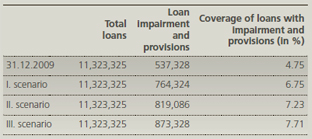
All three scenarios assume a fixed total exposure amount. The impact of stress scenarios results in impairment and provisions increase within a one-year period and impact the coverage of loans with impairment and provisions. The first scenario requires a 42% increase of impairment and provisions, the second requires an additional 52%, and the third scenario requires an increase of impairment and provisions from Euro 537 million to Euro 873 million (by 63%).
b) Fair value of financial instruments
The fair values of quoted investments in active markets are based on current bid prices (financial assets) or offer prices (financial liabilities). The fair values of financial instruments that are not quoted in active markets are determined by using valuation techniques. These include the use of recent arm’s length transactions, discounted cash flow analysis, option pricing models and other valuation techniques commonly used by market participants. The valuation models reflect current market conditions at the measurement date which may not be representative of market conditions either before or after the measurement date. As at the balance sheet date management has reviewed its models to ensure they appropriately reflect current market conditions, including the relative liquidity of the market and credit spreads. Changes in assumptions about these factors could affect reported fair values of trading assets and liabilities and available for sale financial assets.
The Bank measures fair values of derivative financial instruments by using market prices (Mark to Market), in accordance with the Methodology for Valuation of Derivative Financial Instruments. Foreign exchange rates, interest rates and volatility curves are based on the Market Snapshot principle. Market data is saved daily at 4 p.m. and later used for calculation of fair values (Market value, NPV) of derivative financial instruments. For valuation of derivatives the Bank applies market yield curves.
c) Impairment of available for sale equity investments
The Bank determines that available for sale equity investments are impaired when there has been a significant or prolonged decline in the fair value below its cost. The determination of what is significant or prolonged requires judgment. In making this judgment, the Bank evaluates among other factors, the normal volatility in share price. In addition, impairment may be appropriate when there is evidence of deterioration in the financial health of the investee, industry and sector performance, changes in technology, and operational and financing cash flows.
In 2009 NLB recorded impairment loss on investments in the amount of Euro 4.8 million (2008: in the amount of Euro 60.6 million).
d) Held to maturity investments
The Bank classifies non-derivative financial assets with fixed or determinable payments and fixed maturity as held to maturity investments. Before making this classification the Bank evaluates its intention and ability to hold such investments to maturity. If the Bank fails to keep these investments to maturity other than for the specific circumstances it will be required to reclassify the entire class as available for sale. The investments would therefore be measured at fair value not amortized cost. If the entire class of held to maturity investments is tainted, the fair value would increase by Euro 18,927 thousand (31 December 2008: increase by Euro 12,054 thousand), with a corresponding entry in the fair value reserve in shareholders’ equity.
e) Impairment of investments in subsidiaries, associated and jointly controlled entities
The process of identifying and evaluating impairment is inherently uncertain because it require significant management judgment in making a series of estimates, the results of which are relatively sensitive to the assumptions used. The review of impairment represents management's best estimate of the factors such as:
- Future cash flows of the investments are sensitive to the cash flow projected for the periods for which detailed forecasts are available and to assumptions regarding the long-term pattern of sustainable cash flow thereafter. The cash flow used represent management's view of future business prospects at the time of assessment.
- Discount rate derived from a Capital Asset Pricing Model and used to discount future cash flows is based on the cost of equity assigned to an individual investment. Discount rate reflects range of financial and economic variables including risk free rate and risk premium. The variables are subject to fluctuations outside management's control.
Management believes that the sensitivity analysis of impairment testing is adequately robust to reasonably possible changes in underlying assumptions.
f) Income taxes
The deferred tax assets recognized at 31 December 2009 have been based on future profitability assumptions over a five year horizon. In the event of changes to these profitability assumptions, the tax assets recognized may be changed.
g) Employee benefits
The present value of the employee benefits depends on factors that are determined on an actuarial basis using a number of assumptions. Any changes in these assumptions will impact the carrying amount of the obligation. The Bank determines the appropriate discount rate at the end of each year. This is the interest rate that should be used to determine the present value of estimated future cash outflows expected to settle the obligation. In determining the appropriate discount rate, the Bank considers the interest rate of high quality corporate bonds.
h) Investment properties
Management estimates the fair values of investment properties by discounting expected net rentals at market yields.
2.27. Adoption of new and revised International Financial Reporting Standards
In the current year, the Bank has adopted all of the new and revised Standards and Interpretations issued by the International Accounting Standards Board (the IASB) and the International Financial Reporting Interpretations Committee (IFRIC) of the IASB that are effective for accounting periods beginning on 1 January 2009.
The following new standards and amendments to standards have been early adopted:
- IFRS 3 (amendment), Business Combinations and consequential amendments to IAS 27 (amendment), Consolidated and Separate Financial Statements, IAS 28 (amendment), Investments in Associates and IAS 31(amendment), Interests in Joint Ventures, effective prospectively to business combinations for which the acquisition date is on or after the beginning of the first annual reporting period beginning on or after 1 July 2009. The revised IFRS 3 continues to apply the acquisition method to business combinations with some significant changes. For example, all payments to purchase a business are to be recorded at fair value at the acquisition date, with contingent payments classified as debt subsequently re-measured through the income statement. There is a choice, on an acquisition by acquisition basis, to measure the non controlling interest in the acquiree either at fair value or at non controlling interest's proportionate share of the acquireer’s net assets. All acquisition related costs should be expensed. This will enhance the relevance, reliability and comparability of information about business combinations, transactions with non controlling shareholders, changes of the entity’s status and their effects on financial statements. The most important impact on consolidated financial statements of amended standards relates to treatment of transactions with non controlling owners. All effects of such transactions are recognized within equity without any changes of goodwill. This amendment does not impact separate financial statements.
Accounting standards and amendments to existing standards effective on or after 1 January 2009 that were endorsed by EU:
- IFRS 2 (Amendment) Share based payment – Vesting conditions and cancellations. The changes pertain mainly to the definitions of vesting conditions and the regulations for the cancellation of a plan by a party other than the company. These changes clarify that vesting conditions are solely service and performance conditions. As a result of the amended definition of vesting conditions, non vesting conditions should now be considered when estimating the fair value of the equity instrument granted. In addition, the standard describes the posting type if the vesting conditions and non vesting conditions are not fulfilled. The amendment does not effect on the Banks financial statements.
- IFRS 5 (Amendment) - Non-current Assets Held for Sale and Discontinued Operations. The amendment proposes that all assets and liabilities of a subsidiary should be classified as held for sale if the parent has a sale plan involving loss of control of the subsidiary. The amendment also clarifies the relevant disclosures for subsidiary required for discontinued operations. The amendment does not effect on the Banks financial statements.
- IFRS 7 (Amendment) - The amendment requires enhanced disclosures about fair value measurements of financial instruments and liquidity risk management. In particular the amendment requires disclosure of fair value measurement by level of a fair value measurement hierarchy. The amendment does not effect the Bank’s operations, but it requires additional disclosures.
- IFRS 8 - Operating segments. IFRS 8 replaces IAS 14. It requires a “management approach” under which segment information is presented on the same basis as that used for internal reporting purposes to the group executive board, which makes decisions on the allocation of resources and assess the performance of the reportable segments. It does not effect the Bank’s operations and disclosures, since segment reporting is disclosed only in consolidated financial statements.
- IAS 1 (Amendment) - Presentation of financial statements. The amendment to the standard requires entities to present all non-owner changes in equity either in one statement of comprehensive income or in two statements (a separate income statement and a statement of comprehensive income). Each component of equity, including each item of other comprehensive income, should be reconciled between the carrying amount at the beginning and the end of the period. The amendment also requires presenting a statement of financial position (balance sheet) as at the beginning of the earliest comparative period in a complete set of financial statements when the entity applies an accounting policy retrospectively or makes a retrospective restatement. The amendment impacts presentation aspects.
- IAS 16 (Amendment) - Property, Plant and Equipment and consequential amendment to IAS 7 - Statement of Cash Flows. Entities whose primary activities comprise renting and subsequently selling assets should present proceeds from the sale of those assets as revenue. Such assets should be classified as inventories from the point that the assets cease to be leased and become held for sale. A consequential amendment to IAS 7 states that cash flows arising from the purchase, rental and sale of such assets are classified as cash flows from operating activities. The amendment impacts presentation aspects.
- IAS 19 (Amendment) - Employee Benefits. The amendment clarifies the distinction between short-term and long-term employee benefits and supplements the definition of benefit obligation. The amendment achieves consistency with IAS 37 - Provisions, Contingent Liabilities and Contingent Assets, which states that contingent liabilities should not be recognized, but should be disclosed. The amendment does not effect the Bank’s financial statements.
- IAS 20 (Amendment) - Accounting for Government Grants and Disclosure of Government Assistance. The amendment requires benefits arising from government loans at below-market interest rates to be accounted for as government grants, with the benefit calculated as the difference between the proceeds and the initial fair value of the loan, net of transaction costs. The amendment does not effect the Bank’s financial statements.
- IAS 23 (Amendment) - Borrowing costs. The amendment requires an entity to capitalize borrowing costs directly attributable to the acquisition, construction or production of a qualifying asset as part of the cost of that asset. The option of immediately expensing those borrowing costs has been removed. The definition of borrowing costs has been amended and adjusted to method in IAS 39 - Financial Instruments: Recognition and Measurement. Consequently the borrowing costs are measured according to the effective interest rate method. The amendment does not have a material effect on the Bank’s financial statements.
- IAS 28 (Amendment) - Investments in Associates and consequential amendments to IAS 32 - Financial Instruments: Presentation and IFRS 7 Reclassification of Financial Assets. The amendment proposes that an investment in an associate should be treated as a single asset for impairment testing. The impairment is not allocated to any assets included within the investment, for example goodwill. Accordingly, reversals of this impairment should be recognized as an adjustment to the investment to the extent that the recoverable amount of the associate increases. The amendment does not effect the Bank’s financial statements.
- IAS 29 (Amendment) - Financial Reporting in Hyperinflationary Economies. The amendment to the standard requires that types of assets and liabilities should be measured at fair value and not by the historical cost approach. The amendment does not effect the Bank’s financial statements.
- IAS 32 (Amendment) - Puttable Financial Instruments and Obligations Arising on Liquidation and IAS 1 Amendment. The amendment requires classification as equity of some financial instruments that meet the definition of a financial liability. Puttable financial instruments that present a residual interest in the net assets of the entity are now classified as equity provided that specific conditions are met. Similar to those requirements is the exception to the definition of financial liability for instruments that entitle the holder to a pro rata share of the net assets of an entity only on liquidation. The amendment does not effect the Bank’s financial statements.
- IAS 36 (Amendment) - Impairment of Assets. The amendment requires increased disclosures if fair value less costs to sell is calculated on the basis of discounted cash flows. The amendment impacts disclosure aspects.
- IAS 38 (Amendment) - Intangible Assets. The amendment clarifies that expenditure on advertising and promotional activities can only be recognized as an expense at the time that the benefit of the goods or services becomes available to the entity. The standard no longer contains the provision that states that there is ’rarely, if ever’ existence of founded reason for using an amortization method that allows lower rates than straight-line amortization method. The amendment does not effect the Bank’s financial statements.
- IAS 39 (Amendment) - Financial instruments: Recognition and Measurement. The amendment clarifies that it is possible to reclassify derivatives used as a hedging instrument into and out of the fair value through profit or loss category in specific circumstances. The amendment permits the designation of assets, liabilities, firm commitments or highly probable forecast transactions as hedged items only when they involve a party external to the entity. When remeasuring the carrying amount of a debt instrument on cessation of fair value hedge accounting, the amendment clarifies that a revised effective interest rate (calculated at the date fair value hedge accounting ceases) is used. This will not give rise to any changes to the Bank’s financial statements.
- IAS 40 (Amendment) - Investment Property and consequential amendment to IAS 16 - Property, Plant and Equipment. Property that is under construction or development for future use as investment property is classified as investment property. Where the fair value model is applied, such property is, therefore, measured at fair value. However, where the fair value of investment property under construction is not reliably measurable, the property is measured at cost until the earlier of the date construction is completed or the date at which fair value becomes reliably measurable. The amendment does not effect the Bank’s financial statements.
- IFRIC 15 - Agreements for the Construction of Real Estate. This interpretation applies to the accounting for revenue and associated expenses by entities that undertake the construction of real estate directly or through subcontractors. It does not have any impact on the Bank’s financial statements.
- IFRIC 16 - Hedges of a Net Investment in a Foreign Operation (effective from 1 October 2008). The interpretation clarifies the accounting treatment in respect of net investment hedging. This includes the fact that the net investment hedging relates to differences in functional currency not presentation currency, and hedging instruments may be held anywhere in the group. It does not have impact on the Bank’s financial statements.
Accounting standards and amendments to standards issued but not yet effective:
The following standards and interpretations have been issued and are mandatory for the accounting periods beginning on or after 1 July 2009.
- IFRS 1 and IAS 27 (Amendment) - Cost of an investment in a subsidiary, jointly controlled entity or associate. The amended standard allows first time adopters to use a deemed cost of either fair value or the carrying amount under previous accounting practice to measure the initial cost of investments in subsidiaries, jointly controlled entities and associates in the separate financial statements. The amendment also removes the definition of the cost method from IAS 27 and requires an entity to present dividends from investments in subsidiaries, jointly controlled entities and associates as income in the separate financial statements of the investor. The amendment will not impact the Bank’s financial statements.
- IAS 39 (Amendment) – Financial instruments: Recognition and measurement – Eligible hedged items. The amendment provides guidance for two situations. With the designation of a one sided risk in a hedged item, IAS 39 concludes that a purchased option designated in its entirety as the hedging instrument of a one sided risk will not be perfectly effective. The designation of inflation as a hedged risk or portion is not permitted expect in particular situations. This will note give rise to any changes to the Bank’s financial statements.
- IFRIC 17 – Distributions of non cash assets to owners. This addresses how the non cash dividends distributed to shareholders should be measured. A dividend obligation is recognized when the dividend was authorized by the appropriate entity and is no longer at the discretion of the entity. This dividend obligation should be recognized at the fair value of the net assets to be distributed. The difference between the dividend paid and the amount carried forward of the net assets distributed should be recognized in profit and loss.The application of IFRIC 17 will have no impact on the financial statements of the Bank.
- IFRIC 18 - Transfer of assets from customers. This clarifies how to account for transfer of items of property, plant and equipment by entities that receive such transfers from their customers. The interpretation also applies to agreements in which an entity receives cash from a customer when that amount of cash must be used only to construct or acquire an item of property, plant and equipment, and the entity must than use that item to provide the customer with ongoing access to the supply of goods and or services. The Bank is not impacted by applying IFRIC 18.
- IFRIC 19 – Extinguishing financial liabilities with equity instruments. It classifies the requirements at IFRSs when an entity renegotiates the terms of a financial liability with its creditor and the creditor agrees to accept the entity’s shares or other equity instruments to settle the financial liability fully or partially. The Bank is not impacted by IFRIC 19.
- IFRS 9 – Financial instruments part 1: Classification and measurement. IFRS 9 was issued in November 2009 and replaces those parts of IAS 39 relating to the classification and measurement of financial assets. The key features are as follows:
- Financial assets are required to be classified into two measurement categories: those to be measured subsequently at fair value, and those to be measured subsequently at amortized cost. The decision is to be made at initial recognition. The classification depends on the entity’s business model for managing its financial instruments and the contractual cash flow characteristics of the instrument.
- An instrument is subsequently measured at amortized cost only if it is a debt instrument and both the objective of the entity’s business model is to hold the asset to collect the contractual cash flows, and the asset’s contractual cash flows represent only payments of principal and interest (that is, it has only basic loan features). All other debt instruments are to be measured at fair value through profit or loss.
- All equity instruments are to be measured subsequently at fair value. Equity instruments that are held for trading will be measured at fair value through profit or loss. For all other equity instruments, an irrevocable election can be made at initial recognition, to recognize unrealized and realized fair value gains and losses through other comprehensive income rather than profit or loss. There is to be no recycling of fair value gains and losses to profit or loss. This election may be made on an instrument by instrument basis. Dividends are to be presented in profit or loss, as long as they represent a return on investment.
- Adoption of IFRS 9 is mandatory from 1 January 2013, earlier adoption is permitted. The Bank is considering the implications of the standard, the impact on the Bank and the timing of its adoption.
3. EVENTS AFTER REPORTING DATE
In March 2010 Supervisory Board of NLB d.d. approved merger with subsidiary company LHB Finance d.o.o. Merger will be formally registered in May 2010 with the accounting date of merger as at 31 December 2009.
4. NOTES TO THE INCOME STATEMENT

Analysis by type of assets and liabilities
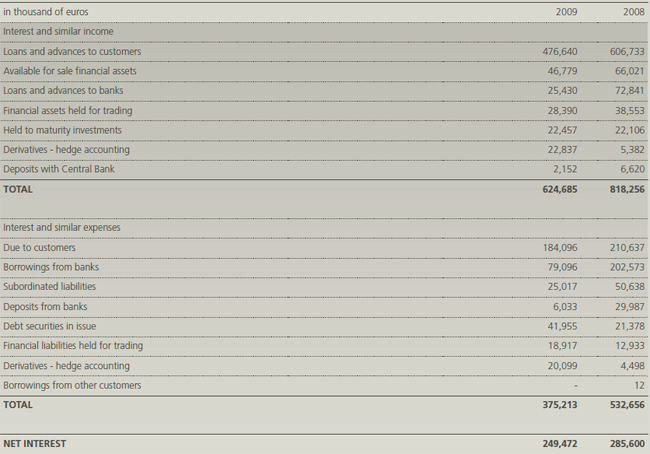
Interest income accrued on impaired financial assets in 2009 is Euro 5,239 thousand (2008: Euro 4,209 thousand).


a) Fee and commission income and expenses relating to activities of the Bank
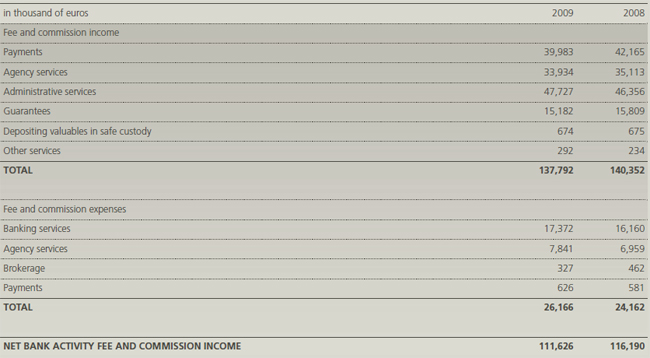
b) Fee and commission income and expenses relating to fiduciary activities
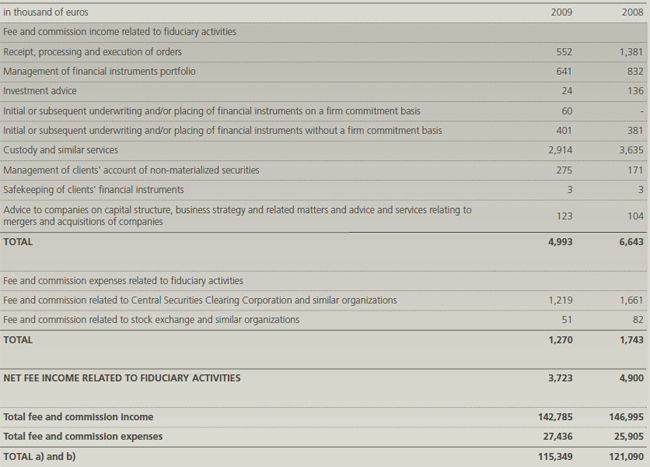

Foreign exchange translation net losses on financial assets and liabilities not classified as at fair value through profit or loss, amounted to Euro 5,142 thousand in 2009 (2008: net gains Euro 39,534 thousand).
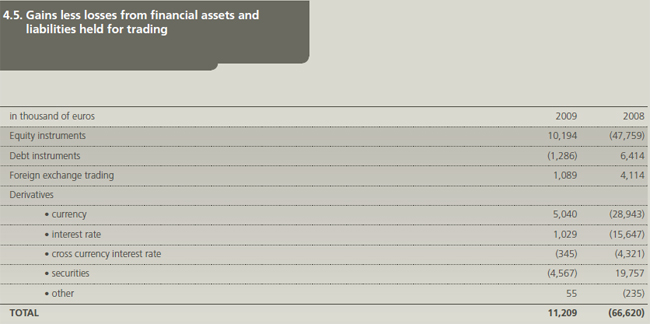
The Bank uses currency derivatives to hedge its currency exposure. For this purpose their effects need to be considered in relation to currency exchange differences within the Income statement. From the business perspective these derivatives represent effective hedging instruments that are not accounted for using hedge accounting principles. In the Bank’s financial statements they are accounted for as financial instruments held for trading.
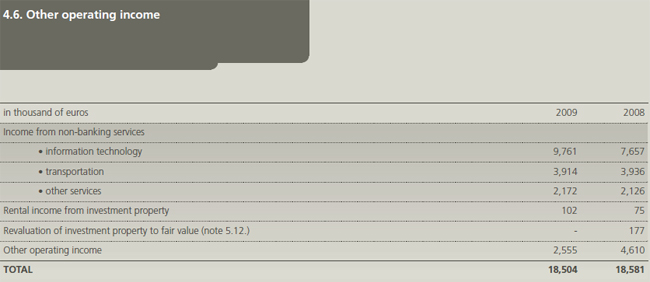
Other income includes bonuses from insurance premiums and compensated court taxes.

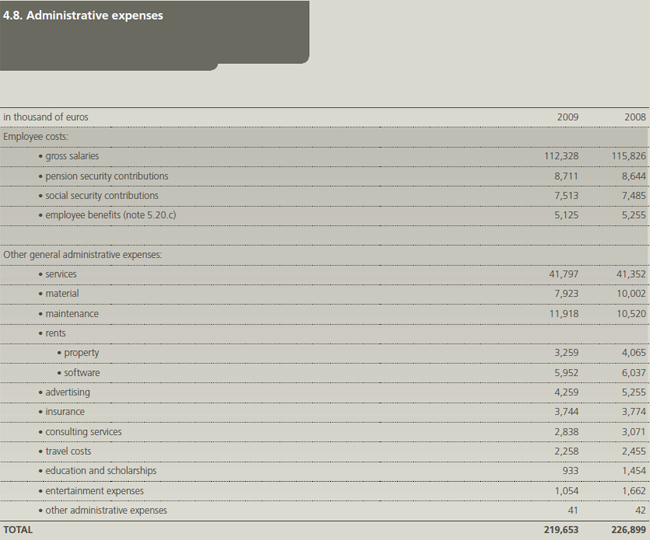
The number of employees in the Bank as at 31 December 2009 was 4,050 (31 December 2008: 4,097).
External audit services

External audit services include payments to statutory auditor in the amount of Euro 500 thousand (2008: Euro 271 thousand).


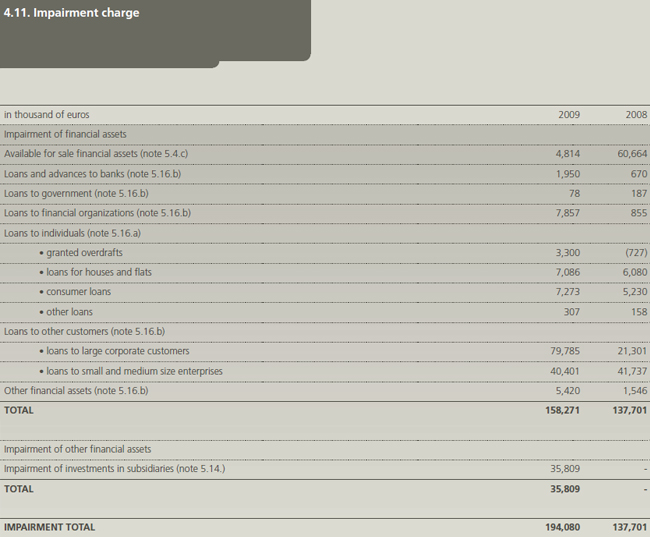
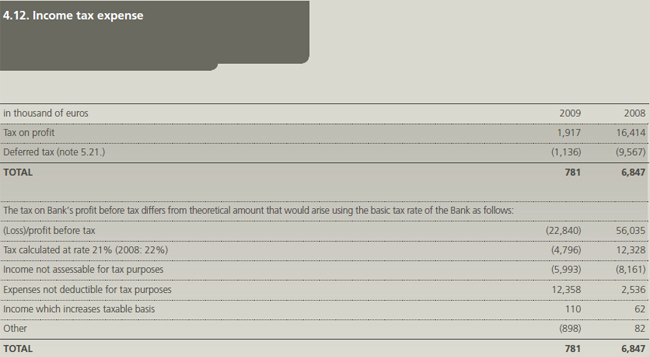
Income not assessable for tax purposes relates mainly to dividend income, which can be, if fulfilling all requirements of the Corporate Income Tax Law, can be eliminated from the tax base.
The expenses not deductable for tax purposes in 2009 relate to impairment of investment in subsidiaries (see note 5.14.a).
The tax authorities may at any time inspect the books and records within 5 years subsequent to the reported tax year, and may impose additional tax assessments and penalties. The Bank’s management is not aware of any circumstances that may give rise to a potential material liability in this respect.

Basic earnings per share are calculated by dividing the net profit by the weighted average number of ordinary shares in issue, less treasury shares.

Subordinated loans and debt securities in issue have no future conversion options and consequently there are no potential dilutive ordinary shares.
5. NOTES TO THE STATEMENT OF FINANCIAL POSITION
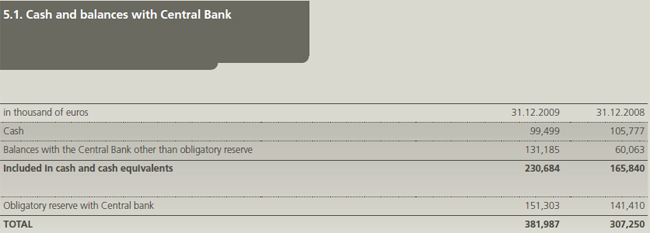
The Bank is required to maintain an obligatory reserve with the Bank of Slovenia, relative to the volume and structure of its customer deposits.
The current requirement of the Bank of Slovenia regarding the calculation of the amount to be held as obligatory reserve is 2% of all time deposits with maturity up to two years.
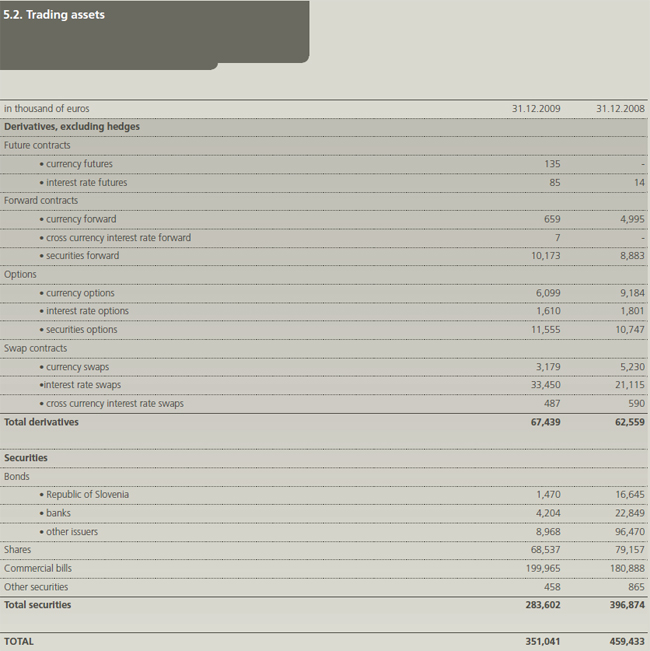
During the year 2009 the Bank reclassified certain bonds from trading category to loans and receivables group. The Bank reclassified high quality corporate bonds that are not traded in the market and for which it has positive intent and ability to hold for the foreseeable future or until maturity rather than trade in the short term.
The following table shows the carrying values at 31 December 2009 and fair values of the assets reclassified:

For the years ended 31 December 2009 and 31 December 2008, fair value gains of Euro 179 thousand and Euro 586 thousand, prior to reclassification, were recognized in the income statement on the reclassified bonds.
Effective interest rates on financial assets reclassified into loans and receivables group as at their respective dates of reclassification fell into the range 4.15% - 4.23%. Interest income recognized after reclassification amounted to Euro 2,836 thousand.
Estimated amounts of undiscounted cash flows the Bank expects to recover from reclassified bonds as at the date of reclassification.

As at 31 December 2009 securities held for trading amounting to Euro 58,820 thousand were quoted on the stock exchange (31 December 2008: Euro 340,519 thousand).
As at 31 December 2009 and 31 December 2008 the Bank has no trading assets with original maturity up to three months that would be included within cash equivalents.
The total amount of the change in fair value estimated using a valuation technique that was recognized in profit or loss during 2009 was positive in the amount of Euro 14,664 thousand (2008: negative in the amount of Euro 31,606 thousand).
Notional amounts of derivative financial instruments are disclosed in note 5.29.d).

Financial assets designated at fair value through profit or loss also include private equity fund in the form of venture capital investments. These investments are managed and evaluated on a fair value basis and total return in accordance with the investment strategy which among other terms also defines the required returns and exit strategy.

a) Analysis by type of available for sale financial assets
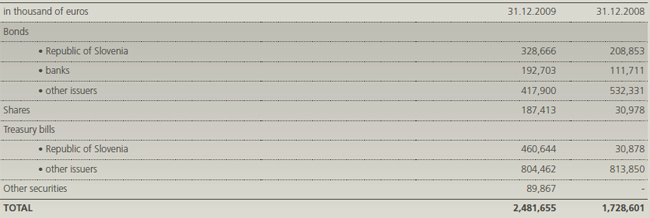
b) Analysis of movements

As at 31 December 2009 the investment securities amounting to Euro 2,380,595 thousand (31 December 2008: Euro 1,709,296 thousand) were quoted on the stock exchange.
As at 31 December 2009 and as at 31 December 2008 the Bank has no available for sale financial assets with original maturity up to three months.
As at 31 December 2009 the Bank has no securities pledged to third parties in sale and repurchase agreements (31 December 2008: Euro 400,682 thousand). For 2008 these securities were presented separately in the statement of financial position as pledged assets.
Impairment of equity securities in the amount of Euro 4,814 thousand (31 December 2008: Euro 60,664 thousand) has been recorded due to decline of prices in Ljubljana Stock Exchange (note 4.11.).
The value of financial assets, available for sale that the Bank obtained by taking possession of collateral held as security and recognized them in the statement of financial position is Euro 156,756 thousand (31 December 2008: nil).
Available for sale financial assets in the amount of Euro 715,057 thousand (31 December 2008: Euro 521,933 thousand) have a remaining contractual maturity of more than twelve months.
c) Revaluation reserve


a) Fair value hedge

Net losses on hedging instruments amounted to Euro 4,970 thousand in 2009 (2008: gains Euro 3,281 thousand) and gains on hedged items were Euro 4,909 thousand (2008: losses Euro 3,208 thousand).
b) Cash flow hedge

Future cash flows

c) Revaluation reserve
A loss on hedging instruments in the amount of Euro 830 thousand (2008: loss Euro 5,157 thousand) was recognized directly in other comprehensive income, as well as the corresponding deferred income tax asset in the amount of Euro 121 thousand (31 December 2008: income tax asset Euro 1,090 thousand). Effect net of tax was loss Euro 709 thousand (2008: loss Euro 4,067 thousand). There was no ineffectiveness that the Bank should have recognized in the income statement. Effects are recycled to net interest income in the income statement.

The Bank implemented two types of hedging relationships for interest rate risk. The most often used solution is fair value micro hedge, but the Bank used cash flow micro hedge as well. The Bank measures hedge effectiveness by using the dollaroffset method.
The Bank hedges its interest rate exposure by using different financial instruments (IRS, FRA, OIS, IR Futures), however, hedge relationships were imposed only in case of hedging by Interest Rate Swaps.
The Bank measures its interest rate exposure by using the repricing gap analysis and by calculating sensitivity of balance sheet and off balance sheet items from economic value of capital point of view. For a portfolio of banking book securities a duration limit is set.
The Bank hedges open positions within individual time buckets and because long positions are more common than short ones, Fair Value Hedges are mainly done for hedging fixed rate assets. Some Cash Flow Hedges were introduced for the same reason - swapping the floating interest rate of certain liabilities into the fixed rate to fund fixed rate assets.
The Bank rarely hedges the fair value of liabilities; however some fixed rate bonds issued were swapped into floating to reduce the repricing gap within certain time buckets.
Cash flows of the hedging instrument match cash flows of the hedging item (principal terms match) in each hedging relationship.

IFRS 7 specifies a hierarchy of valuation techniques based on whether the inputs to those valuation techniques are observable or unobservable. Observable inputs reflect market data obtained from independent sources; unobservable inputs reflect the Bank’s assumptions. These two types of inputs have created the following fair value hierarchy:
- Level 1 – Quoted prices (unadjusted) in active markets for identical assets or liabilities. This level includes listed equity securities and debt instruments on exchanges and exchanges traded derivatives.
- Level 2 – Inputs other than quoted prices included within Level 1 that are observable for the asset or liability, either directly (that is, as prices) or indirectly (that is, derived from prices). The source of input parameters like yield curve and counterparty credit risk is Reuters.
- Level 3 – Inputs for the asset or liability that are not based on observable market data. This level includes equity investments and derivatives linked to these investments.
This hierarchy requires the use of observable market data when available. The Bank considers relevant and observable market prices in its valuations where possible.
a) Financial instruments, measured at fair value in financial statements
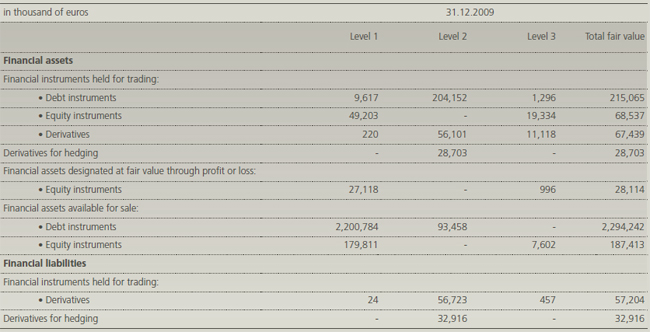
In 2009 there were no transfers of financial instruments between fair value levels of measurement.
b) Financial instruments valued by 3rd level
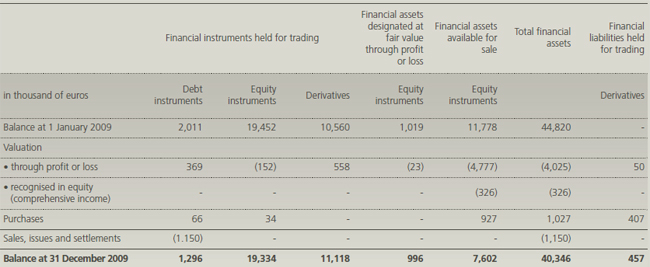

Analysis by type of advance

Loans and advances to banks in the amount of Euro 199,017 thousand (31 December 2008: Euro 240,804 thousand) are expected to be recovered after more than twelve months.
Loans and advances to banks in the amount of Euro 569,757 thousand (31 December 2008: Euro 376,938 thousand) have an original maturity up to three months and are included within cash equivalents.

Analysis by type of advance

In the case of securities purchased under agreements to resell the Bank records these securities as a collateral (the Bank becomes their legal owner), but the borrower is entitled to coupon interest and dividends. During the presented years the Bank did not sell or repledge any of the securities purchased under agreements to resell.
Loans and advances to customers in the amount of Euro 4,543,186 thousand (31 December 2008: Euro 4,664,680 thousand) are expected to be recovered after more than twelve months.

a) Analysis by type of held to maturity investments

b) Analysis of movements

As at 31 December 2009 and 31 December 2008 all held to maturity investments were quoted on the stock exchange.
Held to maturity investments in the amount of Euro 492,428 thousand (31 December 2008: Euro 509,854 thousand) have a remaining contractual maturity of more than twelve months.
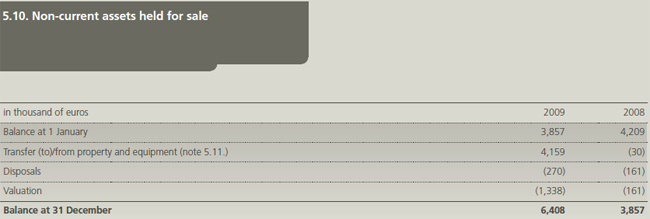
Non-current assets held for sale include business premises which are in the course of sale and assets received as collateral. The amount of non-current assets held for sale that the Bank obtained by taking possession of collateral held as security and recognized them in financial statements is Euro 1,506 thousand (2008: Euro 2,748 thousand).
The effects of valuation and sale are included in the income statement in item Net (loss)/profit from non-current assets held for sale.
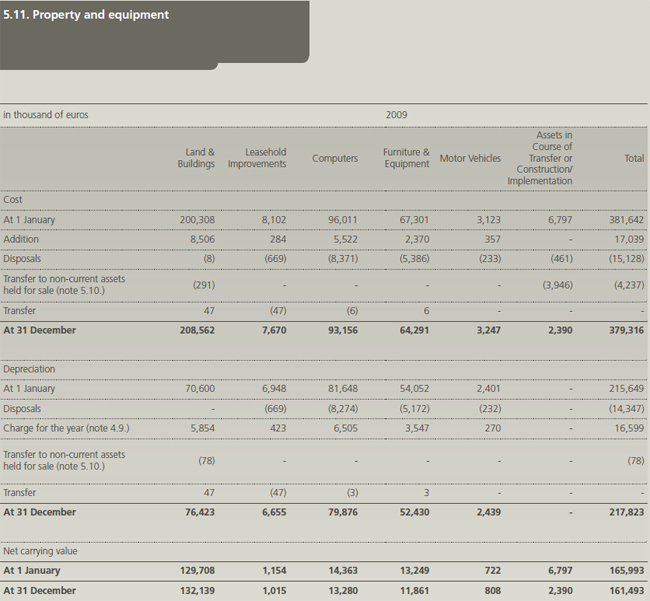
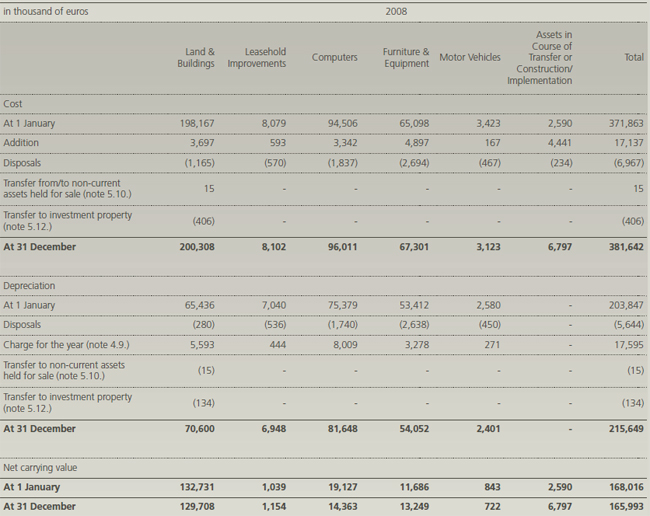
The amount of property and equipment that the Bank obtained by taking possession of collateral held as security and recognized them in the balance sheet is Euro 7 thousand (2008: Euro 7 thousand).

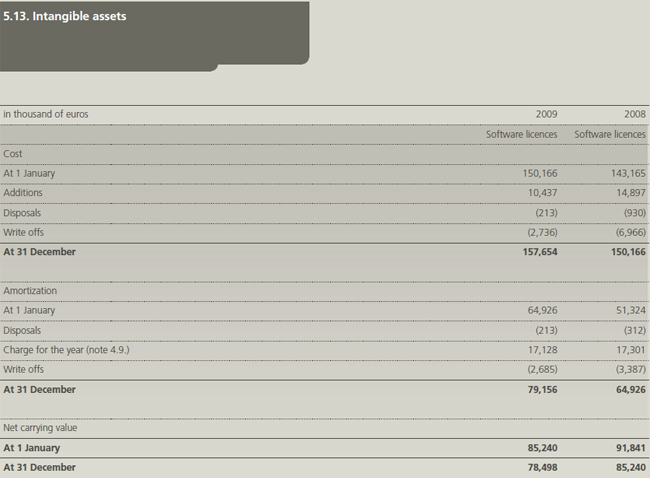

a) Analysis by type of investment in subsidiaries

As a consequence of global financial crisis and difficult conditions the Bank performed an impairment test of individual investments in subsidiaries as at 31 December 2009. According to the requirements of IFRS and internal methodology the Bank calculated recoverable amount of each investment. The calculation is based on the value in use concept including following assumptions:
- A financial budget for a three years period approved by Management Board and supervisors;
- Extrapolation of approved plans for a five years period considering stable growth rate;
- A growth rate of the cash flow in residual period between 3% - 3.5%;
- A discount rate between 13.8 % - 17 %;
- Target capital ratios of an individual bank between 12% - 15%.
The financial budgets of individual companies are based on previous experiences and assessment of future economic conditions that will impact an individual subsidiary’s business and the quality of the credit portfolio. The discount rates used are based on assessment of general and specific risk that an individual subsidiary’s business is exposed to. The discount rates are calculated on the basis of CAPM model.
According to the management the growth rates used in the residual period correspond with long term growth rates in those markets and industry.
In the year 2009 the Bank recorded an impairment loss in the amount of Euro 35,809 thousand for investments in LHB Internationale Handelsbank AG, Frankfurt/Main, NLB Tuzlanska banka d.d., Tuzla and NLB Razvojna banka A.D., Banja Luka.
Majority of impact relates to effects derived from financial crises, larger impairment provisions, higher interest rates on deposits, large decline in GDP for Balkans region, change in capital regulation that requires additional capital increases or results in smaller dividend payout.
The Bank's subsidiaries as at 31 December 2009 are:
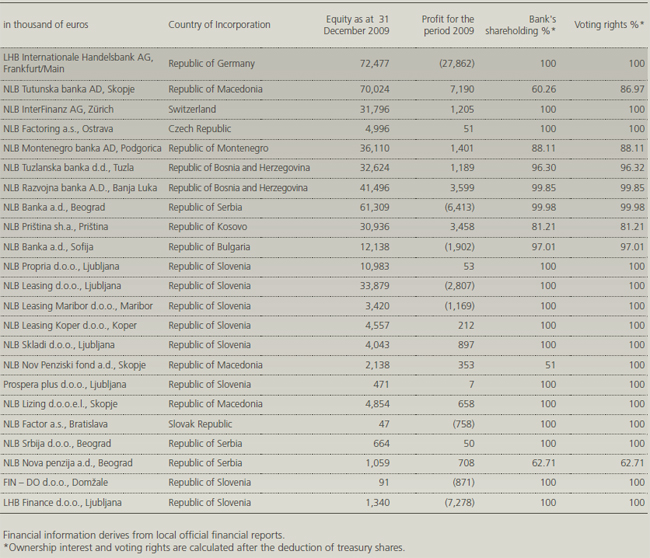
NLB increased in 2009 its ownership interest in following banks:
- NLB Razvojna banka a.d., Banja Luka from 81.50% to 99.85%,
- LHB Internationale Handelsbank AG, Frankfurt/Main from 98.95% to 100%,
- NLB Banka a.d., Beograd from 92.54% to 99.98%.
The Bank's subsidiaries as at 31 December 2008 are:
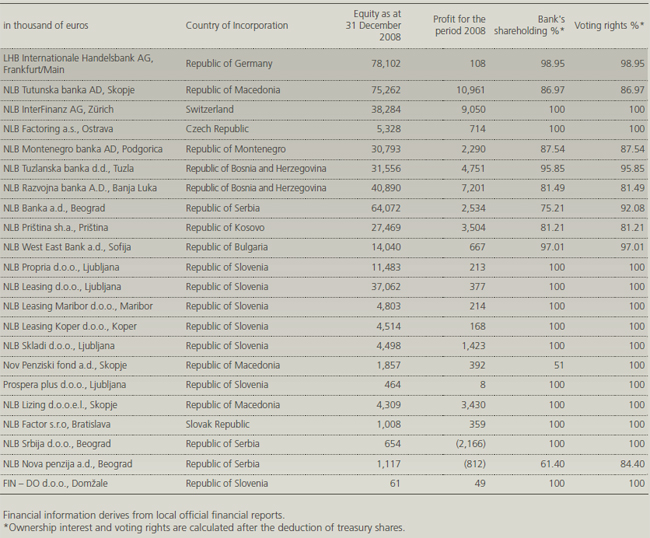
b) Analysis by type of investment in associated companies and jointly controlled

Associated companies of the Bank are:
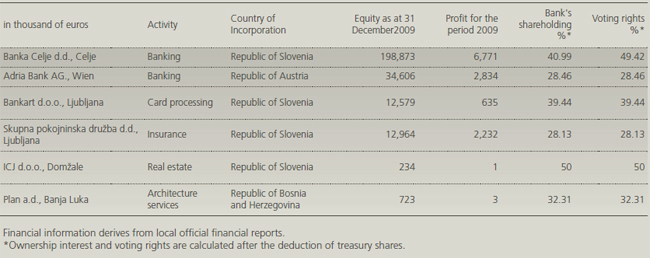

Jointly controlled companies are:
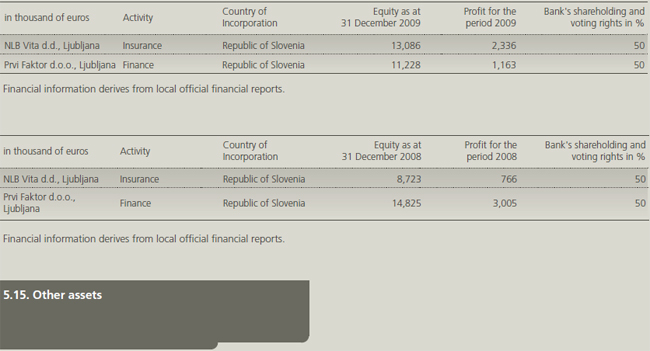
Analysis by type of assets
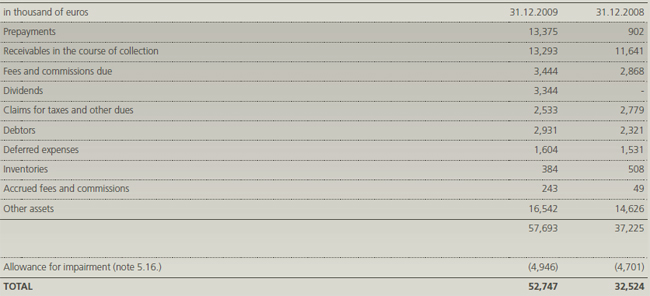
All other assets, except for inventories and claims for taxes and other dues, are financial assets and are measured at amortized cost.
Receivables in the course of collection are temporary balances that, according to the functionality of the information support system, are transferred to the appropriate item of other assets within next few days after occurrence.

a) Loans and advances to individuals
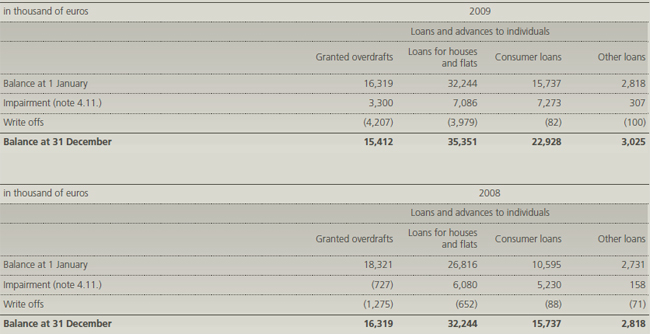
b) Loans and advances to legal entities and other assets
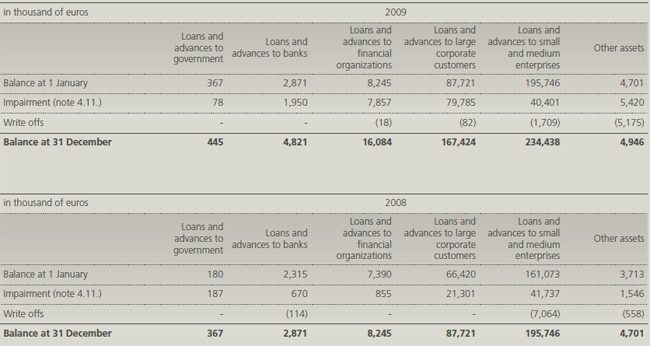
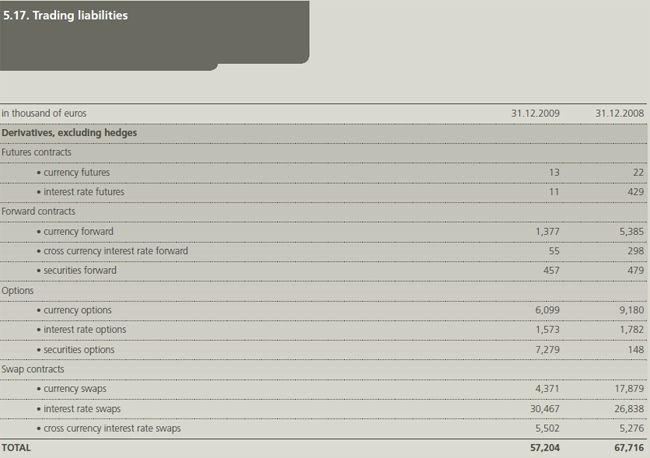
Notional amounts of derivative financial instruments are disclosed in note 5.29.d).

a) Deposits from banks and amounts due to customers

Deposits in the amount of Euro 965,896 thousand (31 December 2008: Euro 290,643 thousand) are expected to be settled after more than twelve months.
b) Borrowings from banks and other customers

Loans in the amount of Euro 1,433,130 thousand (31 December 2008: Euro 1,877,570 thousand) are expected to be settled after more than twelve months.
c) Pledged assets
As at 31 December 2009 the Bank has no pledged assets. As at 31 December 2008 the Bank had pledged assets amounted to Euro 400,682 thousand with related liability amounted to Euro 400,518 thousand.
d) Debt securities in issue
In July 2009 the Bank successfully issued in international financial markets securities with the guarantee of the Republic of Slovenia. Securities were issued in the amount of Euro 1.5 billion with the coupon of 3.25% per year.
All debt securities in issue relate to issued bonds and are denominated in Euro. 94.01% of them have fixed interest rates (31 December 2008: 60.3%) and 5.99% have floating interest rates (31 December 2008: 39.7%). As at 31 December 2009 all debt securities in issue with the carrying amount of Euro 1,757,310 thousand (31 December 2008: Euro 462,284 thousand) were quoted on active markets. Issued securities in the amount of Euro 1,731,246 thousand (31 December 2008: Euro 275,875 thousand) have remaining maturity of more than twelve months.
During the years presented there were no defaults on the securities in issue.
e) Deposits and borrowings from Central Bank
The Bank also identified a pool of securities eligible for borrowings from the Central Bank. As at 31 December 2009 the amount of eligible securities is Euro 800,624 thousand (31 December 2008: Euro 554,915 thousand) and the counterparty liability of Euro 800,000 thousand (31 December 2008: Euro 200,000 thousand) is presented within deposits and borrowings from Central Bank. The Bank has retained legal and economic ownership of these securities.
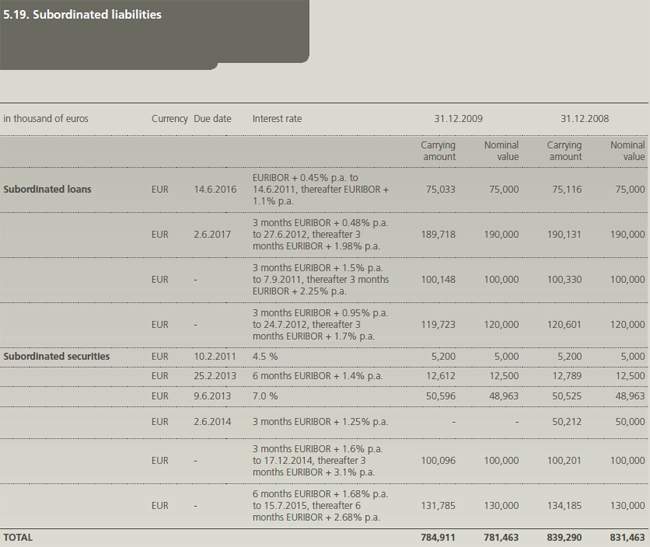
In accordance with the Regulation on capital adequacy of banks and savings banks, four subordinated long-term loans and issued subordinated securities are included in the Bank’s Tier 2 capital as at 31 December 2009. The issued subordinated securities do not contain any provisions on conversion to capital or any other liabilities. In 2009 the Bank did not issue any new subordinated liabilities.
Subordinated loans in the amount of Euro 120 millions and Euro 100 millions are hybrid instruments as defined with the Regulation on capital adequacy of banks and savings banks. The instrument can be repaid by the option of the Bank, the withdrawal or redemption is first possible only after minimum of five years and one day after issue and with prior approval of the Bank of Slovenia. Subordinated securities in the amount of Euro 130 million are quoted at the Luxemburg stock exchange and have the nature of innovative instrument. Their main characteristics are:
- Instrument is “bearer” type (entitle the holder).
- The instrument is perpetual, and the Bank has no obligation to repay principal amount. The Bank has the right to redeem bonds on each interest payment day after the 10 year period from the issuance day, in rare cases redemption in possible also after the period of 5 years but in both cases only with prior approval of the Bank of Slovenia.
- Interest is paid semi-annual in arrears.
- Payments from this instrument are non cumulative.
- They are able to absorb losses on a going-concern basis.
- They are subordinated to depositors, general creditors and subordinated debt instruments, which means that in the case of the Bank's bankruptcy these instruments rank just above non - cumulative preference shares and ordinary shares.
- They are neither secured nor covered by a guarantee of the Bank or related entity or any other form of arrangement that legally or economically enhances the seniority of the claim.
- The withdrawal or redemption of the instruments by the Bank or the acceptance of the instrument as collateral for a claim is first possible only after a minimum of five years after the issue and with the prior approval of the Bank of Slovenia. The condition for approval is that the Bank will replace the instruments with another form of capital of the same or better quality, unless the Bank of Slovenia determines that even without the innovative instruments the capital is more than adequate to the risk assumed by the Bank and its commercial strategy. From the day it is withdrawn, redeemed or accepted as collateral an innovative instrument no longer meets the conditions for inclusion in the calculation of the own funds.
- Proceeds must be immediately and unconditionally available to the Bank.
- In the event that the Bank has no distributable profit, the Bank must have discretion of not paying out interest on innovative instruments and Bank must have full access to waived payments.
- Distributions can only be paid out of distributable items. Where the distributions are preset, they may not be reset based on the credit rating of the Bank.
Subordinated liabilities in the amount of Euro 780,030 thousand (31 December 2008: Euro 780,171 thousand) have remaining maturity of more than twelve months.
During the years presented there were no defaults on subordinated liabilities.

a) Analysis by type of provisions

b) Movements in provisions for guarantees and commitments

c) Movements in employee benefit provisions

Employee benefit provisions include jubilee bonuses, retirement indemnities, uncased annual leaves and termination benefits that are provided as a result of an offer made to employees in order to encourage retirements before the normal retirement date.
d) Movements in provisions for premiums from National Saving Scheme

According to the covenants of the National Saving Scheme, the Housing Fund of the Republic of Slovenia was required to contribute one monthly premium per year to all depositors of the Scheme. The Bank is required to refund invested premiums to the Housing Fund for all depositors that decide not to raise a loan after the conclusion of the Scheme, which is why the Bank has formed a provision for the expected amount of such premiums.
e) Movements in other provisions

Other provisions relate to claims for additional interest relating to retail savings and deposits.
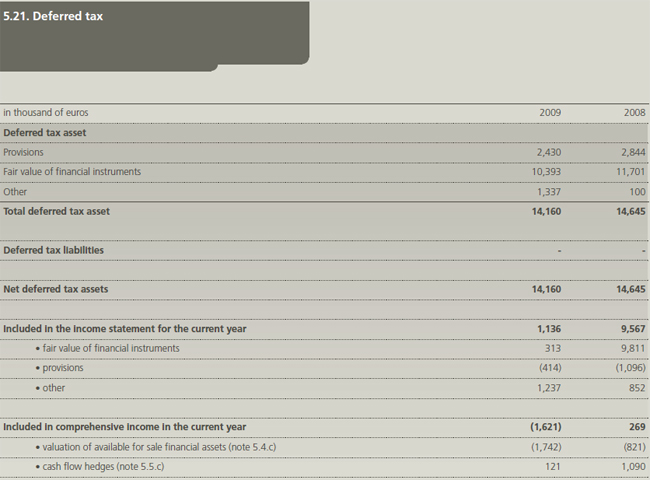
Expenses from adjustment of deferred tax receivables to lower tax rate in 2009 amounted to Euro 758 thousand (2008: Euro 542 thousand).
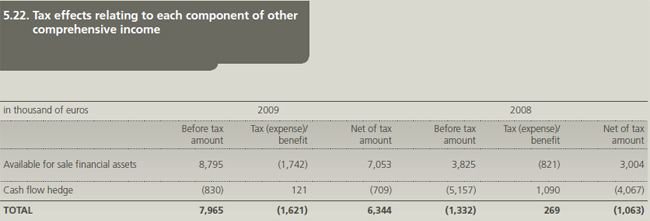

Analysis by type of other liabilities

All other liabilities, except for taxes payable, are financial liabilities and are measured at amortized cost.

As at 31 December 2009 subscribed capital amounts to Euro 74,328 thousand and it is divided into 8,905,952 ordinary shares. In 2008 the Bank increased subscribed capital with the issue of new ordinary shares. The Bank increased its subscribed capital by Euro 7,497 thousand by issuing 898,204 new shares, which represents 11.22% increase in subscribed capital. Prior to the issue of new shares, subscribed capital amounted to Euro 66,831 thousand and was divided into 8,007,748 shares.
The shares are no-par value. All shares are ordinary, freely transferable, with voting rights, issued in non-material form and registered on the accounts of shareholders at the Central Securities Clearing Corporation. All shares are of the same class and subscribed. Shareholders have the right to participate in the governance of the Bank, to receive dividends and they are entitled to part of the assets in the event of a winding-up of the Bank, as determined by law.
As at 31 December 2009 there were 1,998 shareholders (31 December 2008: 1,976), of which 272 are legal entities, 1,709 individuals and 17 non-residents. Compared to year-end 2008 the number of shareholders has increased by 22. 1 share is held by the Bank’s subsidiary (31 December 2008: 1 share). The Bank has 34,924 treasury shares for which it has set aside reserves in the amount of Euro 2,048 thousand.
Pursuant to a decision of the Annual General Meeting the Bank paid in 2009 a dividend for 2008 of Euro 0.33 per share amounting to total dividend payment of Euro 2,927 thousand (2008: Euro 47,469 thousand).

The share premium consists of the paid up premiums in the amount of Euro 446,390 thousand (31 December 2008: Euro 446,390 thousand) and the revaluation of subscribed capital from previous years in the amount of Euro 49,205 thousand (31 December 2008: Euro 49,205 thousand).
Profit reserves in the amount of Euro 604,148 thousand (31 December 2008: Euro 605,915 thousand) present retained earnings that were transferred to reserves in accordance with the decision of the Bank’s Annual General Meeting and can not be distributed in the form of dividends.
The Bank recorded net loss in the amount of Euro 23,621 thousand (2008: net profit 24,594 thousand) and therefore no distributable profit is available for the year 2009.
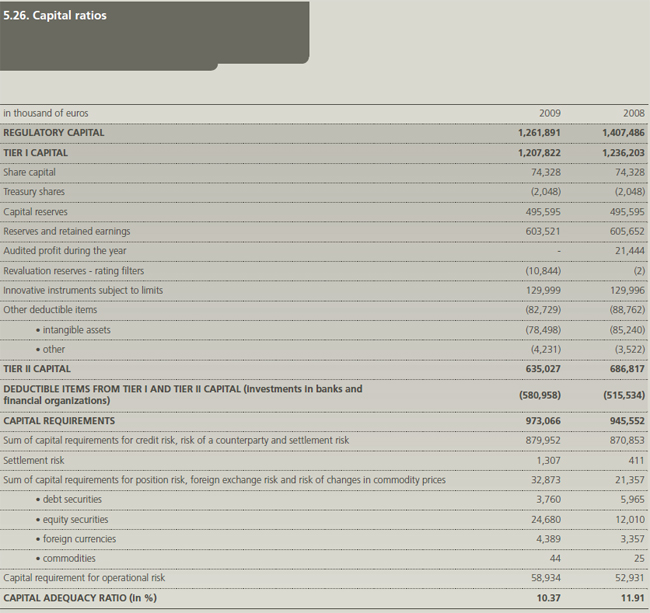
Capital adequacy and capital are monitored in conformity with the guidelines developed by the Basel Committee and the European Community Directives, as implemented by the Bank of Slovenia. The required information is filed with the Bank of Slovenia on a quarterly basis.
The Bank of Slovenia requires each bank to hold the minimum level of subscribed capital of Euro 5,000,000 and to maintain a capital adequacy ration at or above 8%. During the presented years the Bank complied with all of the externally imposed capital requirements to which it is subject.
Characteristics of capital components are described in the Regulation on Capital Adequacy of Banks and Saving Banks.
Tier II capital includes hybrid instruments, subordinated debt and innovative instruments in the amount that exceeds restrictions for inclusion in Tier 1 capital and available for sale revaluation reserve and adjustment to valuation of investment property. The extent of subordinated debt included in Tier II capital is gradually decreasing with a 20% cumulative discount in the last five years before maturity.
In line with capital regulation in 2008 the Bank also calculated the capital requirement for operational risk.
In the first half of the year 2009, call option on subordinated debt in amount of Euro 50 million was exercised.

The Bank has a branch in Trieste with total assets amounting to Euro 189,259 thousand as at 31 December 2009 (31 December 2008: Euro 231,086 thousand) and net profit for 2009 Euro 441 thousand (2008: Euro 1,366 thousand).

The Bank manages assets totaling Euro 6,150,329 thousand (31 December 2008: Euro 5,967,242 thousand) on behalf of third parties. Assets managed on behalf of third parties are comprised of fiduciary activities in amount of Euro 5,451,439 thousand (31 December 2008: Euro 5,167,549 thousand), difference in the amount of Euro 698,890 thousand (31 December 2008: Euro 799,693 thousand) relates to settlement and other services in the name and the account of third parties. Managed funds’ assets are accounted for separately from those of the Bank. Income and expenses of these funds are for the account of the respective fund and no liability falls on the Bank in connection with these transactions. The Bank is compensated for its services with fees. Commissions from these activities in 2009 amounted to Euro 5,392 thousand (2008: Euro 7,069 thousand), of which Euro 4,993 thousand (2008: Euro 6,643 thousand) relate to fiduciary activities (see note 4.3.b) and the rest to settlement and other services in the name and the account of third parties.
Fiduciary activities
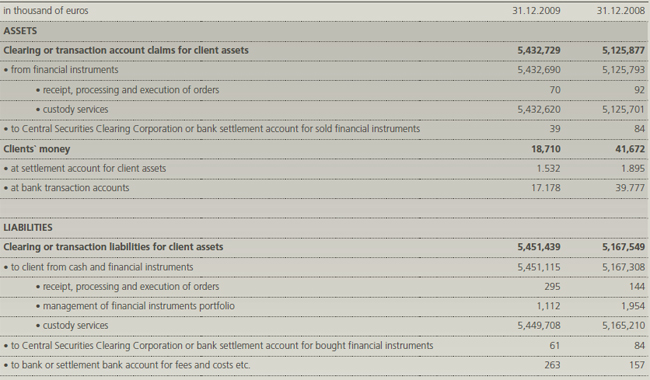

a) Contingent liabilities and commitments
A documentary (and standby) letters of credit constitutes a definite undertaking of the issuing bank, provided that the stipulated documents are presented to the nominated or the issuing bank and that the terms and conditions of the credit are complied with:
- If the credit provides for sight payment – to pay at sight,
- If the credit provides for deferred payment – to pay on the maturity date determinable in accordance with the stipulations of the credit.
Such undertakings can also be issued for credits received in the form of confirmation. It is usually done at the request or authorization of the opening bank and constitutes a definite undertaking of the confirming bank, in addition to that of the issuing bank.
b) Contractual amounts of the Bank’s off-balance sheet financial instruments
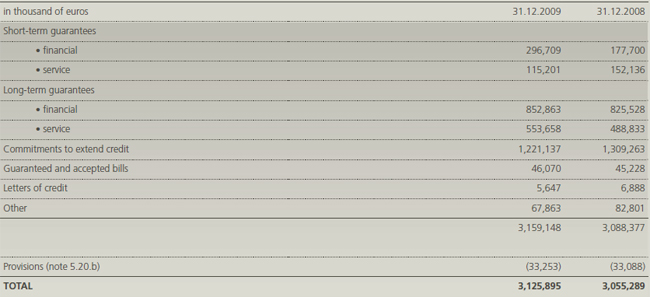
Commitments to extend credit can be realized within one year. The Bank also has no financial guarantees, for which the first possible payment date would be later than within one year.
c) Movement of called service guarantees

Fee income from all issued service guarantees amounted to Euro 6,536 thousand (2008: Euro 6,209 thousand).
d) Analysis of derivative financial instruments by notional amounts
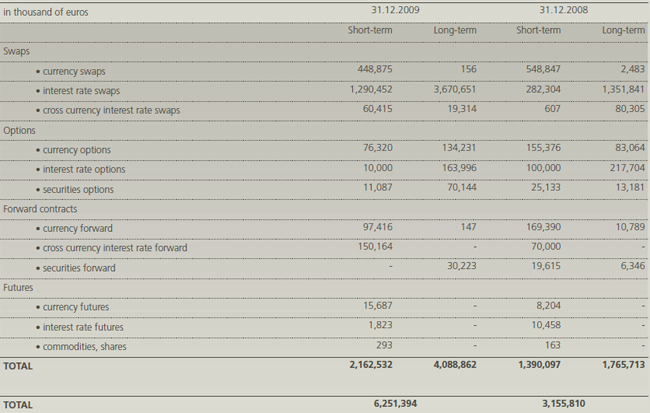
Notional amounts of derivative financial instruments in statements that qualify for hedge accounting amount to Euro 3,101,134 thousand (31 December 2008: Euro 370,362 thousand). Derivatives that qualify for hedge accounting are used to hedge interest rate risk.
Fair values of derivative financial instruments are disclosed in notes 5.2., 5.5. and 5.17.
e) Operating lease commitments
The future minimum lease payments under non cancellable building operating leases are as follows:

f) Capital commitments
As at 31 December 2009 the Bank had capital commitments of Euro 1,162 thousand in respect of implementation of a new information technology system (31 December 2008: Euro 5,747 thousand).
6. RISK MANAGEMENT OF THE BANK
The Bank’s risk management includes a clear organizational structure, effective risk management procedures and an appropriate system of internal controls. The goal is to achieve planned results with minimal risk taking and to optimize the use of regulatory and internal capital.
In managing risks NLB d.d. takes into consideration rules and regulations prescribed by the Bank of Slovenia and internal acts of the Bank. The basic strategy and internal acts, which are regularly updated, discussed at by the Supervisory Board and approved by the Management Board, define the objectives, procedures and methodologies for monitoring, measuring and managing different risks.
In the year 2009 a deepening of the financial crisis continued. The crisis was reflected in the loan activity of the Bank and also in the quality of its portfolio and liquidity problems of some important Bank’s clients. Firms were faced with substantial decrease in demand and sales’ income. In order to avoid losses, the Bank continues with its relatively conservative policy of managing credit risk. The latter encompasses a careful monitoring of clients, the approval of new investments only after obtaining quality collateral as well as obtaining additional collaterals for investments already made.
Regarding market risks NLB also continues to maintain a relatively conservative policy. The exposure of the Bank to these risks is relatively small. Regarding structural liquidity the Bank has formed an adequate level of liquidity reserves in the shape of first rate bonds, which allow for “repo” deals with ECB or on inter-bank market.

The Bank’s credit portfolio includes balance sheet items (loans, securities, interest, fees, commission, etc.) as well as offbalance sheet items (guarantees, letters of credits, commitments and contingencies, derivatives, etc.) towards corporate customers, banks, financial institutions, the public sector, entrepreneurs, retail customers and other customers. By entering into any of the above-mentioned transactions the Bank exposes itself to credit risk, which is the risk that the counterparty will cause a financial loss for the Bank by failing to discharge an obligation.
Prior to credit approval or entering into a contract, which exposes the Bank to credit risk, every customer receives a rating and individual limit. The rating of a customer depends on its financial position, business performance, relationship with the Bank to date, the ability to provide sufficient finance to meet future obligations, also taking into account also country risk exposure.
The risk of individual credit is additionally considered in connection to the entire credit portfolio. Trends in the movements, risks and concentrations of the credit portfolio as a whole and separately for different segments of customers and loans or advances are considered based on the analysis of time series.
Impairment losses and provisions are measured in accordance with the International Financial Reporting Standards as adopted by the European Union, according to the risk of a loan and existence of objective signs of impairment. The amount of impairment loss is also influenced by the collateral if it represents a successful means of repaying the debt in the event of customer’s default.
a) Derivatives
The Bank maintains strict control limits on net open derivative positions, i.e. the difference between purchase and sale contracts, both by amount and term. The bank enters mostly into currency, interest rate derivative contracts (mostly for servicing clients, the Bank closes them “back to back “) equity derivative contracts represent a smaller portion. The amount subject to credit risk is limited to the credit replacement value of the instrument that is determined in accordance with the regulation (based on the sum of current and potential exposure). This credit risk exposure is managed as part of the overall lending limits with customers, together with potential exposures from market movements.
b) Credit related commitments
The primary purpose of these instruments is to ensure that funds are available to customers when required. Guarantees and standby letters of credit, which represent irrevocable assurance that the Bank will make payments in the event that a customer cannot meet its obligations to third parties, carry the same credit risk as loans. Documentary and commercial letters of credit, which are written undertakings by the Bank on behalf of a customer authorizing a third party to draw drafts on the Bank up to a stipulated amount under specific terms and conditions, are collateralized by the underlying shipments of goods to which they relate and therefore carry less risk than direct borrowing. Commitments to extend credit represent unused portions of authorizations to extend credit in the form of loans, guarantees or letters of credit. With respect to credit risk on commitments to extend credit, the Bank is potentially exposed to loss in an amount equal to the total unused commitments. However, the likely amount of losses is less than total unused commitments, since most commitments to extend credit are contingent upon customers maintaining specific credit standards. The Bank monitors the term to maturity of credit commitments because longer-term commitments generally have a greater degree of credit risk than shorter-term commitments.
c) Bank's internal rating system

Credit rating reflects the credit quality of the customer, whose exposure is derived from a financial instrument. Credit rating A stands for a first-class customers, who are not expected to encounter difficulties in repaying their obligations. Credit rating B indicates customers with somewhat worse financial position, which is temporary in nature and does not anticipate difficulties in repaying the obligations. The rating C indicates customers, that are undercapitalized and highly indebted or customers that generally do not generate sufficient cash flow to repay the obligations, so they may encounter repayment delays. Ratings D and E indicate the clients with evident financial difficulties or those who are in the process of compulsory settlement or bankruptcy; it is expected that these clients will not be able to repay most or even any of their obligations from their operating cash-flow. Customers with credit standing of C or worse must provide first-rate collateral to cover their exposure in the amount of credit replacement value.
d) Maximum exposure to credit risk before collateral held or other credit enhancements
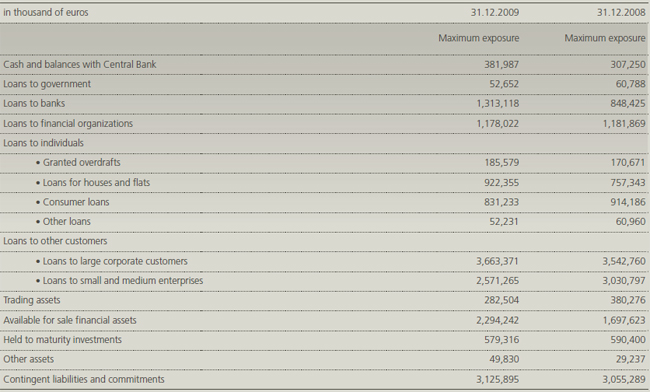
Maximum exposure to credit risk represents a worst case scenario of credit risk exposure, which is the maximum possible loss of the Bank without taking account of any collateral held. For on-balance sheet assets, the exposures set out above are based on net carrying amounts as reported in the balance sheet and for off-balance sheet items they are based on nominal value.
According to internal methodology for loan impairment, all individually significant customers are monthly individually assessed for impairment and if needed, impairment loss is recognized.
In the previous year’s in-depth analyses of customers and careful risk management assured a high quality of the credit portfolio. In the year 2009 the credit portfolio quality worsened due to the financial crisis. This caused an increase in impairment and credit loss provisions for clients which were assessed on the portfolio level - increase of incurred but not reported losses – as well as for clients that were individually assessed, as a result of lower expected repayments. Because of that the coverage of the portfolio with allowances for impairment has been steadily increasing (2008: increasing) and has stabilized at 3.82% (2008: 2.84%) at the end of year 2009. 88% (2008: 92%) of the portfolio is considered to be a quality portfolio.
e) Loans and advances neither past due nor impaired
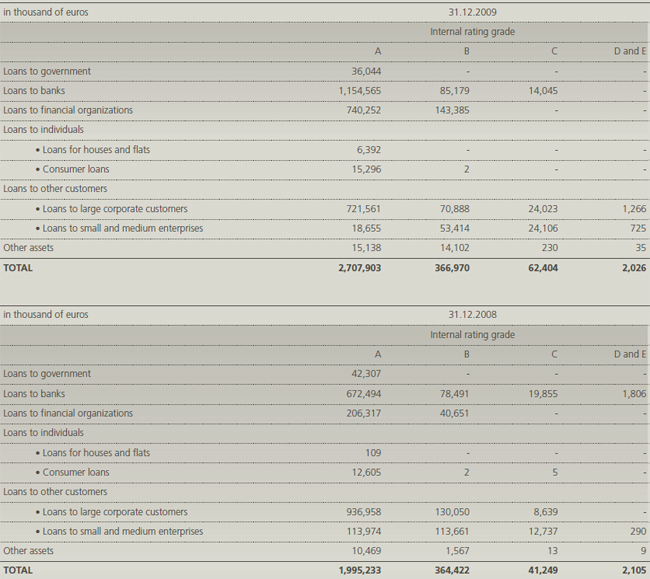
f) Loans and advances past due but not impaired
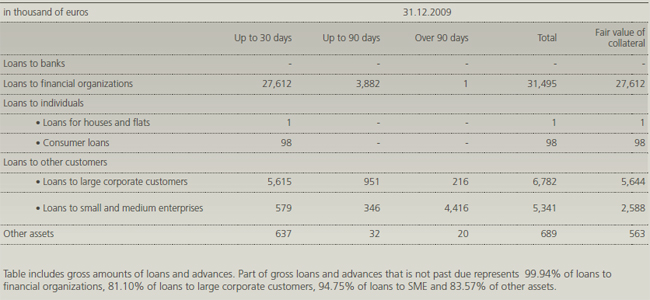
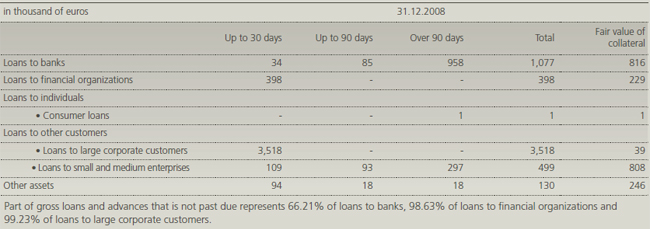
The Bank receives different types of collateral to mitigate credit risk. In the year 2009 the Bank put a special effort into obtaining quality collateral for new and existing investments. The decision about the type and value of collateral depends on customer analysis. The Bank is trying to receive high-quality collateral, which among other things also improves the Bank’s capital and results in lower allowances for loan losses. Long-term loans in particular are collateralized, mostly with mortgages and charges over business assets such as premises, inventory and accounts receivable. The value of collateral is regularly reviewed and in the event of its decrease the Bank requires that the customer provide additional collateral.
g) Impaired loans and advances
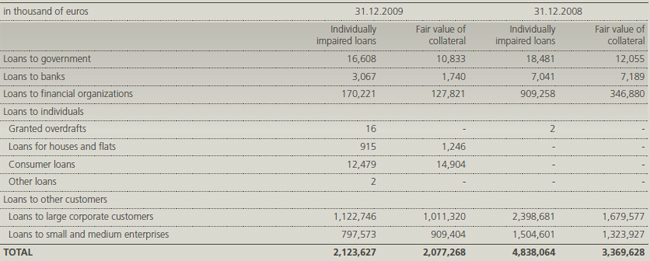
Impairment provisions for individually impaired loans as at 31 December 2009 amounted to Euro 429,261 thousand (31 December 2008: Euro 302,352 thousand).
h) Loans and advances renegotiated
Restructuring activities include extended payment arrangements, approved external management plans, modification and deferral of payments. Following restructuring, a previously overdue customer account is reset to normal status and managed together with other similar accounts. Restructuring policies and practices are based on indicators or criteria that, in the judgment of management, indicate that payment will most likely continue.
Renegotiated loans that would otherwise be past due or impaired totaled Euro 332,801 thousand at 31 December 2009 (31 December 2008: Euro 249,729 thousand).
i) Repossessed property
The Bank obtained assets by taking possession of collateral held as security and recognized it in its balance sheet, as follows:

j) Analysis of loans and advances by industry sectors
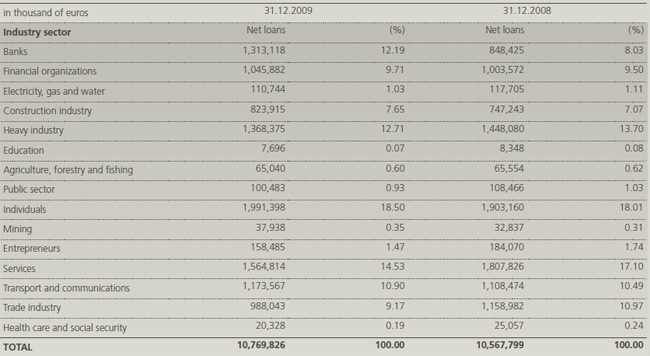
k) Analysis of loans and advances by geographical sectors

l) Analysis of debt securities, treasury bills, other eligible bills and derivative financial instruments by geographical sectors

m) Internal rating of derivatives counterparties

No derivatives in the banking book are entered into with counterparties with external rating less than AA. When derivatives are entered into on behalf of customers all such transactions are covered through back-to-back transactions involving third parties with external rating of AA or above.
n) Debt securities in the Bank’s portfolio that represent subordinated liabilities for the issuer

Securities in the amount of Euro 0 thousand (31 December 2008: Euro 4,813 thousand) represent subordinated bonds of domestic issuer with Fitch LT Issuer Default Rating BBB.
Other issuers (Slovenian banks and financial institutions) don’t have external ratings. Internally they are all rated as A, except for two issuers with B rating. Subordinated liabilities of the B rated issuers in the Bank’s portfolio amounted to Euro 3,086 thousand as at 31 December 2009 (31 December 2008: Euro 2,331 thousand).

Market risk is the risk that the market or fair value of financial instruments could fluctuate due to changes in the interest rate, foreign exchange and equities markets. Market risk management is a process comprising the monitoring and measurement of individual risks with the aim of actively managing the potential negative financial effects that could arise as a result of changes in market prices.
Stress tests are based on the Bank’s relevant net open positions which include all relevant financial instruments considering sensitivity to certain type of market risk (example: hypothetical loss assessment derived from FX risk includes the sensibility of all currencies in which the Bank has an open position). The Bank performs hypothetical and historical scenarios (in accordance with Basel II recommendation). Hypothetical stress scenarios include possible/predictable movements of market rates (example: in the case of an interest rate parallel shift of the yield curve by 200 basis points), meanwhile historical scenarios arise from real historical movements of market rates in the past (example: non-parallel movement of the yield curve based on the historical interest rate volatility). Stress test results are regularly presented to the ALM Committee.
a) Capital markets summary
Slovenia
The Slovenian capital market we saw non-uniformity price movements, especially in the second half of the previous year. The index achieved its highest level on 16 October 2009 at 4,633.4 points (to indicate +26.5% gain compared to the beginning of the year). The index completed previous year gradually lower, ending at 4,078.6 points, to signify 11.4% higher than the year before. Among stocks, included in SBI20, stocks of Zavarovalnica Triglav were the biggest gainers in 2009, posted 66.5% growth. On the prime market the clear winners were stocks of the pharmaceutical company Krka with 32.7% growth. Market capitalization for both, prime and standard markets shares at the end of 2009 stood at 8,461.7 mio Euros, presentation 3.4% more than at the end of 2008. One of the highlights of 2009 was the admission of the LJSE's first ever remote member (ecetra Central European e-Finance AG), which has enabled foreign investors direct access to the Slovene market.
Among the reasons why the Slovenian stock market returns were lower compared to the majority of other markets in 2009 are lessening improvements of Slovenian economic activity compared to those in the west, deteriorated results of Slovenian blue chips, anxiety what the future will bring and outperformance of the SBI20 index in previous years. According to the ATVP there were positive inflows in mutual funds in the second half of 2009, and from July to November positive inflows amounted to 13.7 mio Euros.
The Gross Domestic Product (GDP) in Slovenia expanded at an annual rate of 1% in the third quarter of 2009. Industrial Production in Slovenia expanded 2.7% during the last surveyed month. Slovenia witnessed deflation over four months in 2009, with annual inflation amounting to 1.8%, which is 0.3 percentage points less than in 2008. The weaker macroeconomic picture of the national economy also affected the labor market. At the end of the year there were officially 96,672 unemployed people, the unemployment rate in Slovenia was 10.3% in December of 2009. Compared to December 2008 unemployment was higher by 45.9%.
World
Leading economisis have called the global financial crisis the worst financial crisis since the one related to the Great Depression of the 1930s. It has contributed to the failure of key businesses, declines in consumer wealth estimated in the billions of Euros, substantial financial commitments incurred by governments, and a significant decline in economic activity. The collapse of the global housing bubble, which peaked in the U.S. in 2006, caused the values of securities tied to housing prices to plummet thereafter, damaging financial institutions globally.
The International Monetary Fund (IMF) estimated that large U.S. and European banks lost more than 1,000 billion EUR on toxic assets and from bad loans from January 2007 to September 2009. These losses are expected to top 2,000 billion Euros from 2007-2010. This interrupted the ability of corporations to rollover (replace) their short-term debt. The governments responded by extending insurance for money market accounts analogous to bank deposit insurance via a temporary guarantee and with programs to purchase commercial paper. Total home equity in the United States, which was valued at 9,000 billion Euros at its peak in 2006, had dropped to 6,000 billion Euros by the end of 2008 and was still falling in 2009 (the U.S. home mortgage debt relative to gross domestic product increased from an average of 46% during the 1990s to 73% during 2008). To offset this decline in consumption and lending capacity, the U.S. government and FED have committed 10,000 billion Euros. In effect, the FED has gone from being the "lender of last resort" to the "lender of only resort" for a significant portion of the economy. In some cases the FED was considered the "buyer of last resort." This was the largest liquidity injection into the credit market, and the largest monetary policy action in world history. In the post World War II era, the government has attacked recessions with an average fiscal stimulus of 2.6% of GDP and an average monetary stimulus of 0.3% of GDP, for a combined countercyclical lift of 2.9%. This time out, the fiscal stimulus is likely to measure 10% of GDP, monetary stimulus 9.5% of GDP, for a combined equivalent to 19.5% of GDP.
The underlying debt burden is greater than it was after the World War II. Even without fresh spending, public debt might explode within two years to 105% of GDP in the UK, 100% in the US and the eurozone, and more than 200% in Japan. Worldwide government debt would reach 30,000 billion Euros, up two-and-a-half times in a decade. An over-leveraged economy is one prone to deflation and stagnant growth. The household sector continued to pay down debt for the fourth consecutive quarter. Corporates also started to pay down debt sharply in Q2 2009 at a similar 150 billion Euros pace (only six of the 100 largest US bond issues in 2009 gave investment, capital expenditure or R&D as the reason for obtaining additional money. Instead, companies are mainly seeking to shore up their balance sheets). The non-financial private sector paid down debt at a 350 billion Euros pace in same quarter. With continued private sector de-leveraging likely this year and beyond, relapse back into recession is not something that is not possible. Consumers (USA household debt as a percentage of annual disposable personal income was 127% at the end of 2007, versus 77% in 1990) will almost certainly keep on deleveraging from their debt (in 1981, U.S. private debt was 123% of GDP; by the end quarter of 2008, it was 290%).
It looks like all these massive governments spending helped world economy to grow again. Conditions in financial markets have generally improved in recent months. The rally that brought the stock market back from the brink in 2009 was one of the biggest ever. Markets achieved their lowest point on first half of March last year, since then they progressed at lightning speed. American broad equity index S&P 500 have gained more than 50% in EUR terms since then, DAX more than 55%, Nikkei more than 35%, Russian RTS even more than 140% year to date. From the beginning of this past March, bond mutual funds have received a net inflow of some 150 billion Euros. The comparable total for U.S. equity mutual funds is "just" 7 billion Euros, or less than 5% as much. Economic projections for the developed countries include a return to typical growth levels (GDP) of 2-3% in 2010; an unemployment around 10% with moderation in 2011.
Equity trading portfolios excluding equity investments hedged with forward contracts
Geographical structure

Industry structure
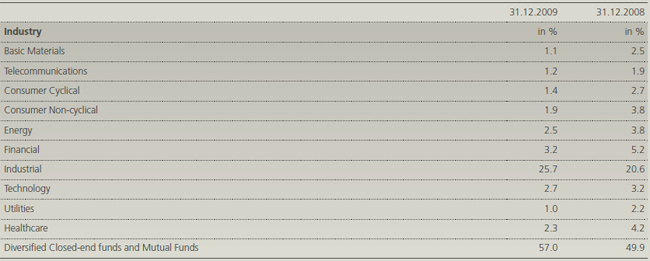
b) Value at Risk methodology
In accordance with IFRS 7 the exposure to market risk is shown through »Value at Risk« (VaR) methodology for currency and other market risks in the trading book (interest rate risk and equity risk). The bank uses VaR methodology on a daily basis for monitoring and managing these risks.
The bank regularly monitors and manages interest rate exposure in the banking book by interest income sensitivity analysis based on the interest rate gap method. In terms of equity investments in the banking book, the exposure to risks is expressed through VaR and sensitivity analysis.
Currency risk
For currency risk the Bank uses an internal »Value at Risk« (VaR) model based on open FX positions. Daily calculation of the VaR value is adjusted to Basel standards (99% confidence interval, monitored period of 300 business days, 10-day of holding a position) and based on the historical simulation method. VaR is calculated for exchange risk for the entire open Bank position (the position of trading and banking book together) because the position is also managed at the entire level by the Treasury department.
Currency risk exposure increased in May 2009 due to an increase in the RSD (Serbian Dinar) currency position arising from a structural mismatch. An increase in the open RSD position is derived from restructured loans, the related currency conversion and the accounting presentation of the advance from the repurchase of a minority share and capital increase of the subsidiary company in Serbia. Apart from the aforementioned position an increase in currency volatilities also contributed to a larger VaR value. This is reflected in a greater average value of FX VaR in the year 2009.
Other market risks in the trading book
The bank uses an internal VaR model based on the variance-covariance method for other market risks. Daily calculation of the VaR value is adjusted to the Basel standards (99% confidence interval, monitored period of 250 business days, 10-day of holding a position).
In 2009, the interest rate risk in the trading book on average amounted to Euro 435 thousand. In 2009 the portfolio of debt securities decreased to Euro 20 mio in terms of market value, whereas the exposure form derivatives trading originated primarily from interest rate future contracts.
The equity risk in the trading book in the year 2009 oscillated between Euro 3.4 and 5.8 mio with the exception of July 2009 when the maximum value of VaR in the amount of Euro 7.8 mio was reached. During this month the value of the strategic portfolio in the trading book increased as received collateral for credit loans was realised by the Bank.
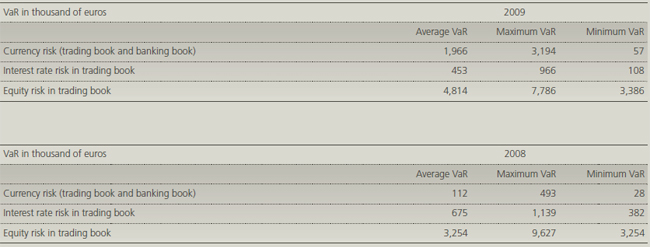
The average, maximum and minimum values in the table above are calculated on the basis of daily VaR calculations based on daily open positions and the fluctuations of market data in the past monitored period (300 or 250 working days). The “average” value represents the arithmetic mean of daily VaR values in 2009, whereas the “maximum” and “minimum” values represent the largest and smallest values of daily VaR calculations in 2009 respectively.
Interest rate risk in the banking book
Interest rate exposure is monitored and managed by using the methodology of interest rate gaps. On the basis of this methodology, the Bank assesses interest income sensitivity. The analysis of interest income sensitivity assumes a shift of the interest rates by 50 basis points in the short term. The analysis is based on the assumption that the positions used remain unchanged and that the yield curve shift is parallel.
The assessment of the affect of the change in interest rates by 50 basis points (+/- 0.5%) on the value of net interest income for the banking book position:


In 2009 the value of interest income sensitivity has remained relatively stable. The exposure to interest rate risk for the most part derives from the portfolio of first rate bonds (ECB eligible), which represent a source of secondary liquidity. The exposure arising from classic loan-deposit deals was relatively low.
The values in the table have been calculated on the basis of monthly calculations of short-term interest rate gaps, in which the applied parallel shift of the yield curve by 50 basis points represents a realistic and practical scenario. The “average” value represents the arithmetic mean of monthly calculations in 2009, while the “maximum” and “minimum” values represent the largest and smallest values calculated in the aforementioned period.
Equity risk of the equities portfolio in the banking book
In terms of equity investments the Bank implements policies for their management that were approved by the Management and the Supervisory board. The policies deal with the allowed investment structure of the portfolio, its diversification, the monitoring and measurement of risks. For monitoring and measuring the risks of the equity portfolio, the Bank uses the standardised methodology as well as an internal model, which has been adapted to the requirements of Basel standards.
The size of the equities portfolio in the banking book amounted to Euro 184.2 mio by the end of 2009 (2009: of this Euro 116.1 mio represented realized collateral and Euro 68.1 mio represented the long-term portfolio; 2008: Euro 23.7 mio). The value of VaR for the equities portfolio in the banking book amounted to Euro 20,105 thousand by the end of 2009 (2008: Euro 3,731 thousand). On the assumption that the stock market indices would fall by 15%, the value of the portfolio would decrease by Euro 27.6 mio.
c) Currency risks (FX)
The Bank manages currency risks in accordance with the adopted Currency risk management policy adopted by the Bank’s Assets and Liabilities Committee. The positions of all currencies in the balance sheet of NLB d.d. for which the limit is set are determined at the daily level.
Exposure to currency risks is monitored and managed by the Assets and Liabilities Management Department on the basis of daily data obtained from the Risk Management Department. ALM manages exposure to currency risks by currency, so that they are always within the limits.
Exposure to currency risks is discussed at daily liquidity meetings and monthly meetings of the Bank’s Assets and Liabilities Committee.
The amount of financial instruments denominated in Euros and in foreign currency
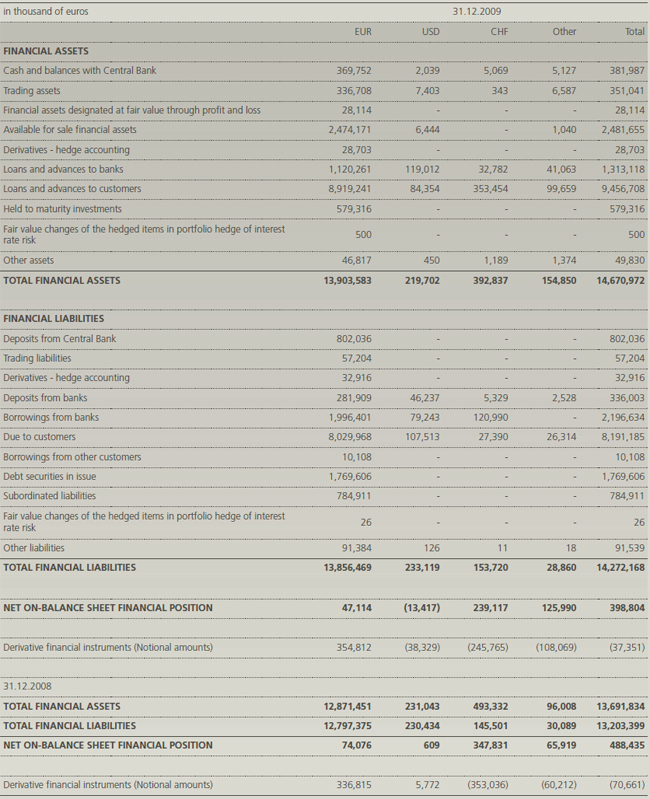
Sensitivity analysis for currency risk
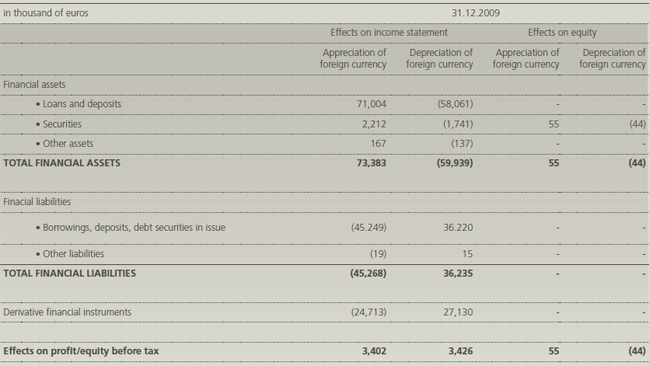
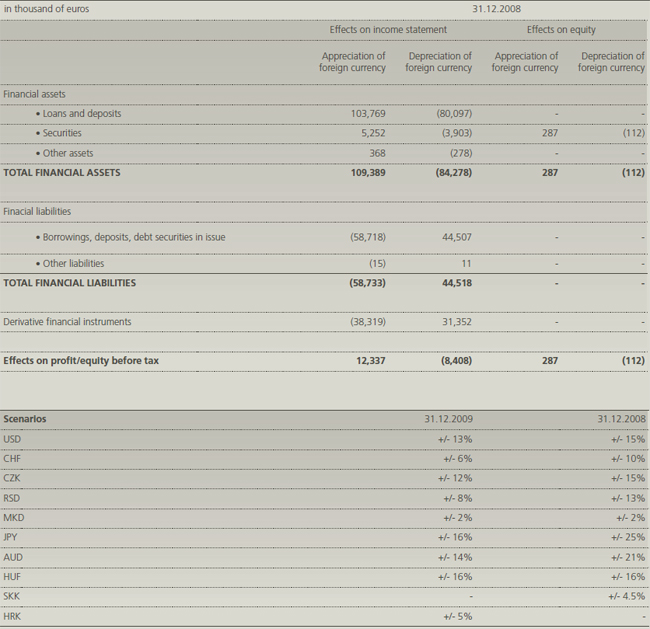
d) Interest rate risk
Management of interest rate risks in the NLB banking book is separated from the measurement and monitoring of such risks. In the past, the Bank has formulated and started implementing the Interest Rate Risk Management Policy, which reflects the conservative strategy of assuming interest rate risks and is based on general Basel standards of risk management.
In the banking book, the Bank has been managing interest rate risks arising from interest-insensitive items on the liabilities side and interest-sensitive items without maturity (available capital and stable sight deposits) separately from all other banking book transactions. The management of interest rate risks arising from interest-insensitive items and items without maturity is provided by means of managing the securities portfolio of the banking book and determining the upper limit of modified duration.
Management of interest rate risks arising from all other banking book transactions is provided based on managing the interest maturity of balance and off-balance sheet items, which the Bank classifies by time gaps. The openness of positions in gaps, in one or other direction, is defined in absolute amount. According to the recommendations of the Basel guidelines, the same restriction is applied to potential changes in the net present value of all interest-sensitive items.
The basic tool for the managing exposure to interest rate risk in the banking book is the management of the Bank’s balance sheet items. The strategies that foresee adequate adjustments to the balance sheet items are treated and adopted at the executive level of the Bank or in the scope of the Bank's Assets and Liabilities Committee. The Bank has above all the following methods for managing its balance sheet:
- Managing the portfolio of debt securities in the banking book;
- Issuing its own securities;
- Introducing new banking products and special treatment of the existing ones; and
- Managing the maturity of existing balance sheet items.
The portfolio of debt securities of the banking book is subject to strict internal regulations defined in the Policy of Managing Debt Securities in the Banking Book. From the aspect of interest rate risk management the main purpose of this portfolio is to achieve stabilisation of the interest margin. In addition, the purpose of the securities portfolio of the banking book is to maintain secondary liquidity reserves. The composition of portfolio and the accounting classification of securities are defined on the basis of permissible credit and non-credit risks and target management of the Bank's capital.
The Bank’s Assets and Liabilities Committee regularly discusses and supervises the adaptation of the offered range and price ratios of banking products in order to limit interest rate risk exposure.
When limiting the exposure to interest rate risks, the Bank also uses the determination of adequate interest maturity of its assets and liabilities.
More precise management of interest rate risk in the banking book is carried out by concluding transactions in derivatives, using the following instruments:
- Interest Rate Swaps;
- Overnight Index Swaps;
- Cross Currency Swaps;
- Forward Rate Agreements; and
- Interest Rate Futures.
Analysis of financial instruments according to the Bank´s exposure to interest rate risk
The tables below summarize the Bank’s exposure to interest rate risks of balance sheet items, without derivatives. They include the Bank’s financial instruments at carrying amounts, categorized by the earlier of contractual repricing or maturity dates.
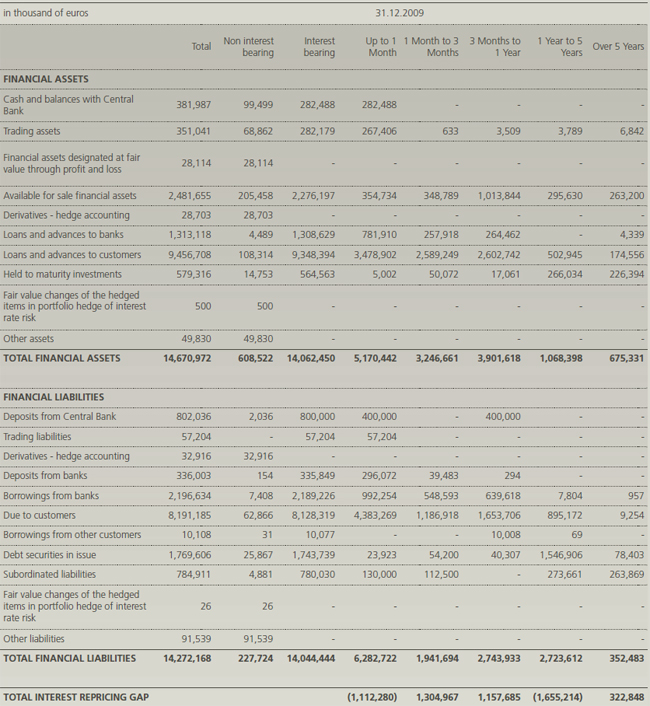
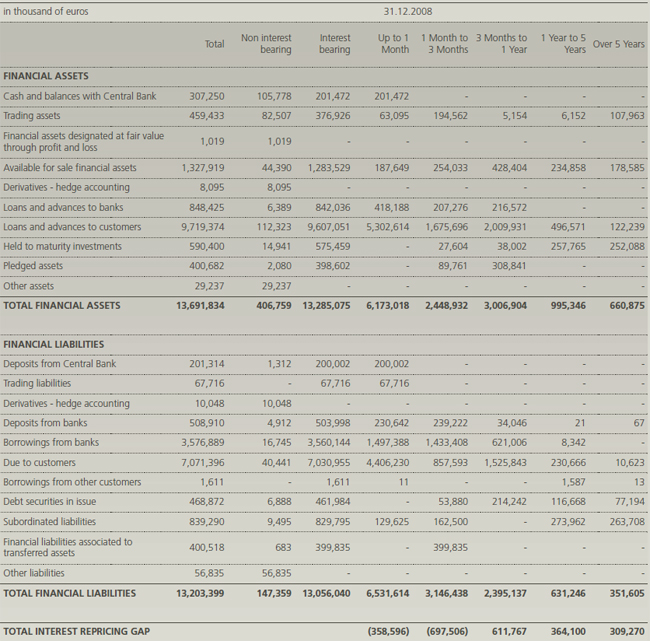
Sensitivity analysis for interest rate risk
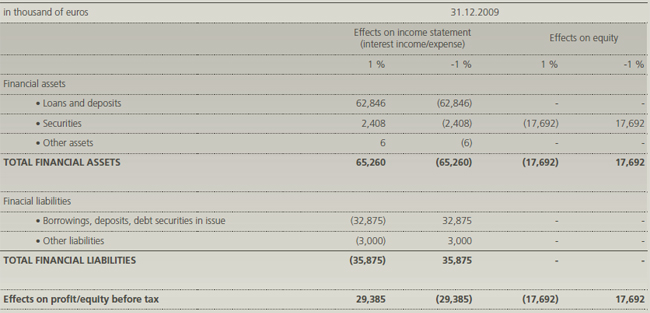
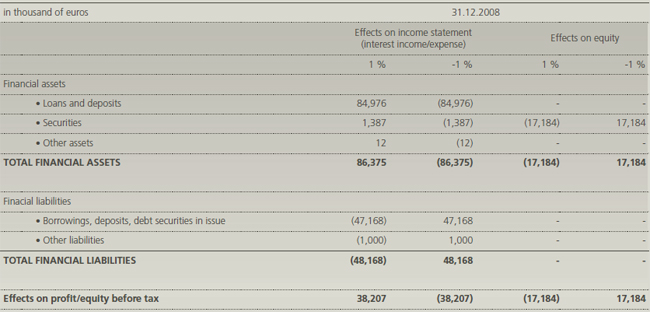
e) Liquidity risk
The entire area of liquidity risk management in NLB is based on the following documents:
- The liquidity risk management policy of NLB d.d.,
- The plan for liquidity management of the Bank in exceptional circumstances, and
- Scenarios for liquidity management in exceptional circumstances.
The Assets and Liabilities Committee adopted the said documents. The Liquidity risk management policy of NLB d.d. specifically defines the methods of measuring, monitoring and managing the Bank's liquidity risk, criteria and scenarios of liquidity management and competencies and responsibilities.
The Plan for liquidity management of the Bank in exceptional circumstances defines guidelines and plan of activities with the aim of recognizing problems, searching for solutions and performing activities in exceptional circumstances as well as establishing a system for managing liquidity of the Bank which ensures maintaining the Bank's liquidity and protection of business interests of clients and shareholders of the Bank.
Pursuant to the Liquidity risk management policy of NLB d. d., the Bank shall be obliged to:
- Ensure sufficient scope of liquidity for the settlement of all the Bank’s liabilities, taking into account the criteria of rationality in the determination of the scope of liquidity reserves,
- Ensure that the Assets and Liabilities Committee of the Bank is regularly informed of the current and potential liquidity needs of the Bank,
- Ensure adequate procedures and methods of work for monitoring and managing the Bank's liquidity,
- Ensure compliance of the Policy with other internal documents regarding the Bank’s assets and liabilities management,
- Ensure accurate understanding of the methods and possibilities of using liquidity reserves,
- Establish a system of regular reporting and informing of the Assets and Liabilities Committee and other competent bodies,
- Ensure compliance of the Policy with the Bank’s plan for liquidity management of the Bank in exceptional circumstances and
- Ensure adequate system of education and support regarding the Bank’s assets and liabilities management.
The Bank manages its liquidity on the basis of three approaches:
- The criterion of liquid assets or structure of the Bank’s balance sheet,
- Alignment of cash flows,
- Combined, using the elements of both approaches (liquidity scale).
Based on the criterion of liquid assets, the Bank shall calculate, at least once a month, the structural liquidity indicators defined in the Policy.
On the basis of the criterion of cash flows alignment, the Bank draws up cash flow plans:
- Daily, for operational purposes, for a period of at least one month,
- Monthly stimulation of cash flows, taking into account all known and expected cash flows,
- Monthly plans of liquidity gaps for different time periods, taking into account several scenarios.
The combined plan of cash flows with the calculation of liquidity quotients comprises:
- A daily report based on the Decision of the Bank of Slovenia on Minimum Requirements for Providing Adequate Liquidity Position of Banks and Savings Banks; and
- A simulation of the changes in liquidity ratio for the months to come.
The Bank manages liquidity at three levels:
- At the operating level,
- At the structural level; and
- In exceptional circumstances.
Liquidity management at the operating level comprises:
- The Bank’s cash flow planning and monitoring,
- Drafting several scenarios of the Bank’s cash flows,
- Monitoring and ensuring compliance with the Central Bank’s regulations related to liquidity,
- Compiling daily and other regular reports for the management of the business line and the Bank, as well as the decision-making bodies,
- Drafting of liquidity stress test scenarios,
- Ensuring adequate technological support for a reliable and efficient monitoring, planning and management of cash flows and
- Drafting of proposals for improvements and changes in the management of the Bank’s operating liquidity.
Liquidity management at the structural level comprises:
- Determining structural liquidity indicators and their regular calculation and monitoring,
- Defining optimal and/or limit values of individual selected structural liquidity indicators,
- Monitoring of trends in the selected structural liquidity quotients,
- Monitoring liquidity gaps according to time intervals (static aspect) and preparing simulations (dynamic aspect);
- Preparing analyses and proposals for the changes in the structure of the Bank’s balance sheet that influence the liquidity position and liquidity risk of the Bank.
The goal of the management of liquidity at the structural level is to achieve a structure of the Bank's balance sheet that will ensure the Bank’s long-term liquidity based on the criteria of long-term maturity, alignment, forms and concentration of the sources of financing and realization and rating of assets.
Liquidity management in exceptional circumstances comprises:
- Preparing the Plan for Liquidity Management of the Bank in Exceptional Circumstances,
- Monitoring of conditions of the Bank’s operations that could influence the methods, possibilities and quality of liquidity management in the Bank and
- Implementing activities defined by the Plan for Liquidity Management of the Bank in Exceptional Circumstances.
The Bank’s liquidity position is discussed daily at liquidity meetings of the business line Financial Markets and Treasury of the NLB Group. As a rule, the Assets and Liabilities Committee monthly discusses the liquidity position and structure of the Bank’s balance, in the case of exceptional circumstances in line with the provisions of the Plan for Liquidity Management of the Bank in Exceptional Circumstances, these issues are also discussed by the Management Board and the operating working group for monitoring liquidity.
Non-derivative cash flows
The tables below present the cash flows payable by the Bank under non-derivative financial liabilities by remaining contractual maturities at the balance sheet date. The amounts disclosed in the table are the contractual undiscounted cash flows, prepared on the basis of spot rates at the balance sheet date.
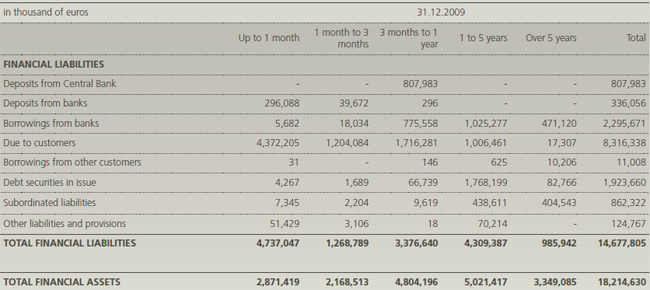
When determining the gap between the financial liabilities and financial assets in the maturity class up to 1 month, it is necessary to take into account the fact that financial liabilities include total sight deposits and that the Bank may apply a stability weight of 50% to sight deposits when assuring compliance with the Central Bank regulations concerning the calculation of liquidity position. To assure Bank liquidity and based on its conservative approach to risk, NLB has already in the preceding years compiled a substantial amount of high-quality liquidity placements, mostly government securities, which are assets accepted as adequate financial assets by the ECB and is also carrying out the activities to enter the selected adequate loans in the loan register kept by the Bank of Slovenia, which will allow the Bank to pledge these loans in order to gain liquidity by using the ECB instruments.
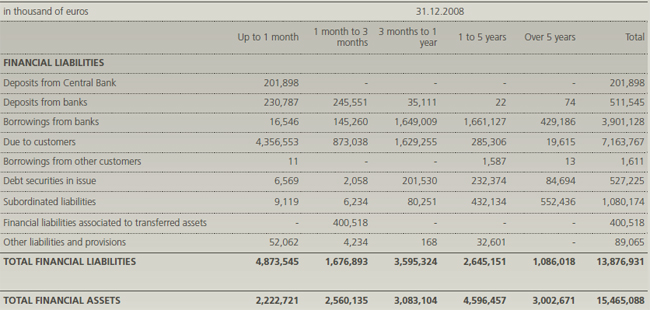
Subordinated liabilities are included in the maturity group based on periods when the call options can be exercised according to the characteristics described in a note 5.19.
Derivative cash flows
All of the Bank’s derivatives, except for some interest rate swaps, are settled on a gross basis. The table below analyses the Bank’s derivative financial instruments into relevant maturity groupings based on the remaining contractual maturity at the balance sheet date. The amounts disclosed in the table are the contractual undiscounted cash flows, prepared on the basis of spot rates at balance sheet date.
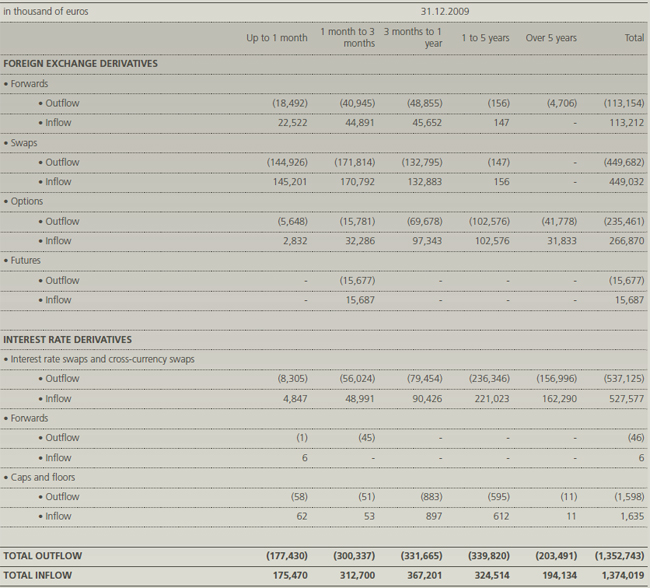
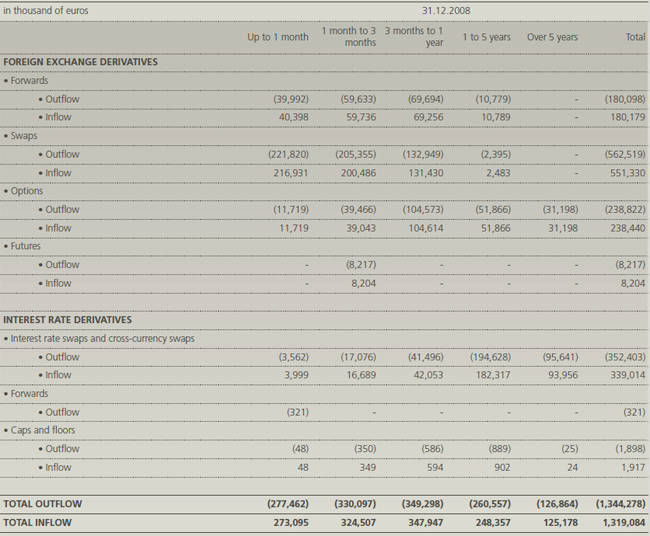
Managing the Bank’s secondary liquidity reserves
The Bank considers prime securities and ECB-suitable loans, on the basis of which it is possible to raise liquid assets on the market or with the Central Bank, as secondary liquidity reserves.
Debt securities are classified into the trading or banking book depending on the purpose of their acquisition and on the planned manner of disposing with them. If, upon their acquisition, the Bank plans to and is capable of holding them until maturity, these securities are posted to the banking book.
The debt securities portfolio of the banking book is used simultaneously for providing secondary liquidity, stabilising interest rate and managing the Bank’s interest rate risk. Securities in the banking book are classified as “available for sale” or “held to maturity”. When managing the portfolio, the Bank uses conservative principles, especially with respect to the structure of portfolio in terms of issuers’ ratings and its maturity. The framework for managing the securities of the banking book is set out by the Policy for managing debt securities in the banking book, which clearly defines the goals and the characteristics of the portfolio of securities of the banking book.
The basic provisions of the Policy for managing debt securities in the banking book:
- Because of the goal of stabilizing the Bank’s interest margin, the securities with a fixed interest rate must account for at least 75% of the total portfolio.
- The largest part of the securities must be comprised of securities that can be pledged with the ECB, i.e. are on the list of acceptable financial assets with the ECB; outside this list there can be no more than EUR 250 million worth of securities;
- Modified portfolio maturity is limited to 3 years for the entire portfolio,
- Up to 40% of the total value of the portfolio can be classified as “held to maturity”,
- There can be no more than EUR 600 million of bank, corporate or structured securities,
- There can be no more than EUR 100 million of structured securities.
As at 31 December 2009, the balance of securities in the banking book was EUR 2,873 million or EUR 569 million more than at the end of 2008. Of these, 88.6% were government securities, 6.2% were state guarantee bonds, 1.3% bank bonds, 3.2% short-term commercial bank bills and 0.7% other corporate bonds. There are no structured securities in the banking book. The majority of securities were invested in Slovenian government securities (35%), followed by Belgian (14%), French (11%), Dutch (7%) and German (7%) government securities.
Euro 2,294 million (80%) of securities were classified as available for sale and EUR 579 million (20%) as held to maturity. Considering the portfolio of securities with interest derivatives, the modified maturity of the banking book portfolio dropped from 1.7 to 1.4 compared to the previous year.
At the end of 2009, the balance of ECB-suitable loans was EUR 698 million or EUR 29 million more than at the end of 2008. The total balance of secondary liquidity reserves of the banking book thus increased in the period from 31 December 2008 to 31 December 2009 by EUR 598 million, i.e. from EUR 2,917 million to EUR 3,515 million.
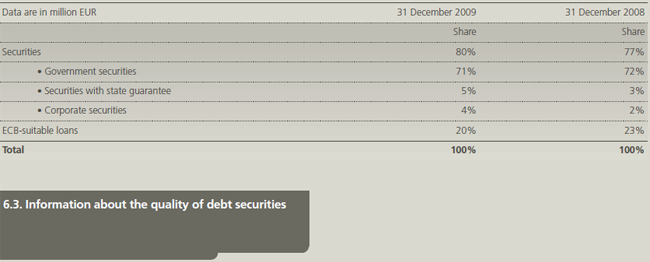
Debt securities are classified either into trading book or into banking book, according to the purpose of acquisition and how they will be managed. Securities that the Bank acquires principally for generating profits between purchase price and selling price are classified into trading book. Securities within the trading book are in financial statements always classified as financial assets held for trading. Securities for which the Bank has the intention to hold to maturity are part of the banking book. In financial statements they are classified as financial assets available for sale or held to maturity investments.
The portfolio of debt securities in the banking book ensures secondary liquidity and manages the interest rate risk of the Bank. When managing the portfolio, the Bank uses conservative principles, especially with respect to issuers’ ratings and maturity of the portfolio.
Structure of banking book according to Fitch ratings:

The portfolio of bonds in the trading book amounted to Euro 15 million as at 31 December 2009 (31 December 2008: Euro 136 million). Bonds from foreign issuers amounted to Euro 1.9 million. The remaining part of the portfolio comprises financial institutions bonds. The Bank also has some short-term securities (certificates of deposits from domestic banks and commercial papers issued by foreign banks). As at 31 December 2009 these securities amounted to Euro 200.4 million, comprising:
- Euro 0.4 million certificates of deposits from domestic banks (31 December 2008: Euro 0.8 million),
- Commercial papers issued by banks with high (only AA) ratings Euro 200 million (31 December 2008: Euro 181 million).

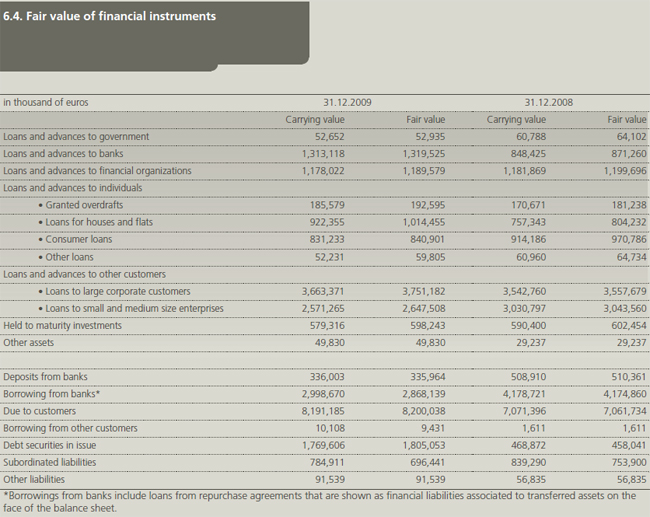
Loans and advances to banks
The estimated fair value of the deposits is based on discounted cash flows using prevailing money market interest rates for
debts with similar credit risk and remaining maturities. The fair value of overnight deposits equals their carrying value.
Loans and advances to customers
Loans and advances are net of allowance for impairment. The estimated fair value of loans and advances represents the
discounted amount of estimated future cash flows expected to be received. Expected cash flows are discounted at current
market rates to determine their fair value.
Deposits and borrowings
The fair value of demand deposits equals their carrying value. However when considering the real value of these deposits to
the depository institution one must consider also timing and amounts of cash flows, current market rates and credit risk of
the depository institution itself. Part of demand deposits are stable similar to term deposits and therefore their economic
value for the Bank differs from the carrying amount.
The estimated fair value of other deposits is based on discounted cash flows using interest rates for new deposits with similar remaining maturities.
Securities held to maturity and debt securities in issue
The fair value of securities held to maturity and debt securities in issue is based on their quoted market price or value calculated by
using discounted cash flows techniques.
Loan commitments
All credit facilities are drawn soon after the Bank grants a loan. Therefore they are drawable at market rates and their fair
value is close to zero.
Other financial assets and liabilities
The carrying amount of other financial assets and liabilities is a reasonable approximation of fair value, because they relate
mainly to short-term receivables and payables.
7. OTHER DISCLOSURES

A number of banking transactions are entered into with related parties in the normal course of business. The volumes of related party transactions and the outstanding balances at year-end are as follows:
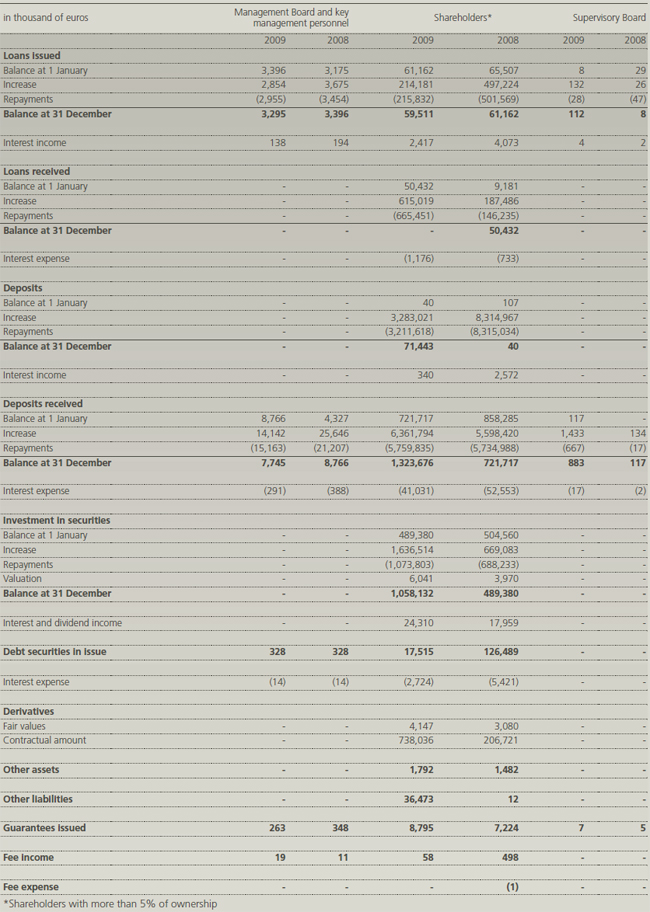
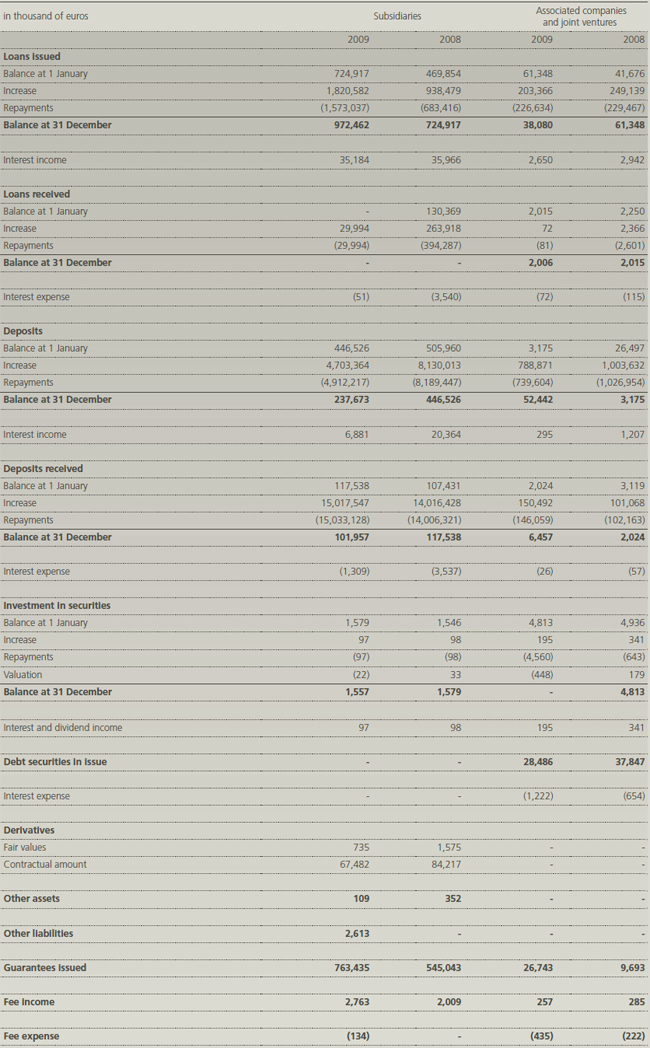
Key management compensation
Considering the Guidelines of the Committee of European Banking Supervisors, the Decision of the Bank of Slovenia on diligence of members of management and supervisory boards of banks and savings banks and in accordance with the competences of the Supervisory Board, as defined by the Articles of Association of NLB d.d., the Supervisory Board adopted the Criteria for remunerating the members of the Management Board in 2010.
The basis for collective remuneration of members of the Management Board is several quantitative indicators comparing:
- The operations of NLB d.d. and the NLB Group compared to the plan (ratio between profit before provisions and capital requirements for risks at the NLB Group level, cost-income ratio (CIR) at the level of the NLB Group);
- The operations of NLB d.d. and the NLB Group compared to the year before (ratio between loans to the nonbanking sector and corporate and retail deposits);
- The operations of NLB d.d. in comparison with banks in Slovenia in the same year (ratio between loans to the non-banking sector and deposits of the non-banking sector);
- The performance of the NLB Group compared to comparable banking groups in the same year (ROE and CIR).
The basis for individual remuneration to members of the Management Board (qualitative part) is individual assignments from the action plan for 2010.

Short term benefits include:
- Monetary benefits (salaries, insurance premiums, holiday bonus, other bonuses) and
- Non monetary benefits (car, health care, apartments).
Costs refund comprises food allowance and travel expenses.
Post employment benefits include pensions, life insurance after termination of employment and health care after termination of employment.
Accrued income by individual member of the Management Board from 1 January to 31 December 2009
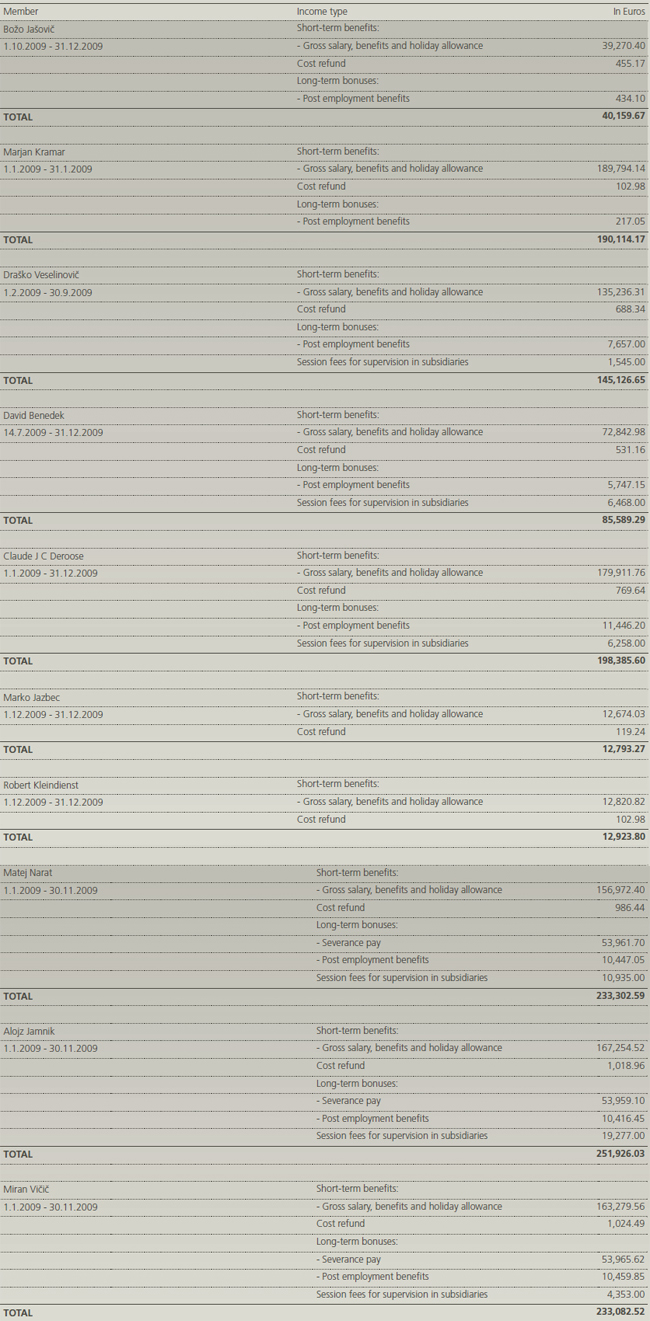
Accrued income by member of the Supervisory Board from 1 January to 31 December 2009
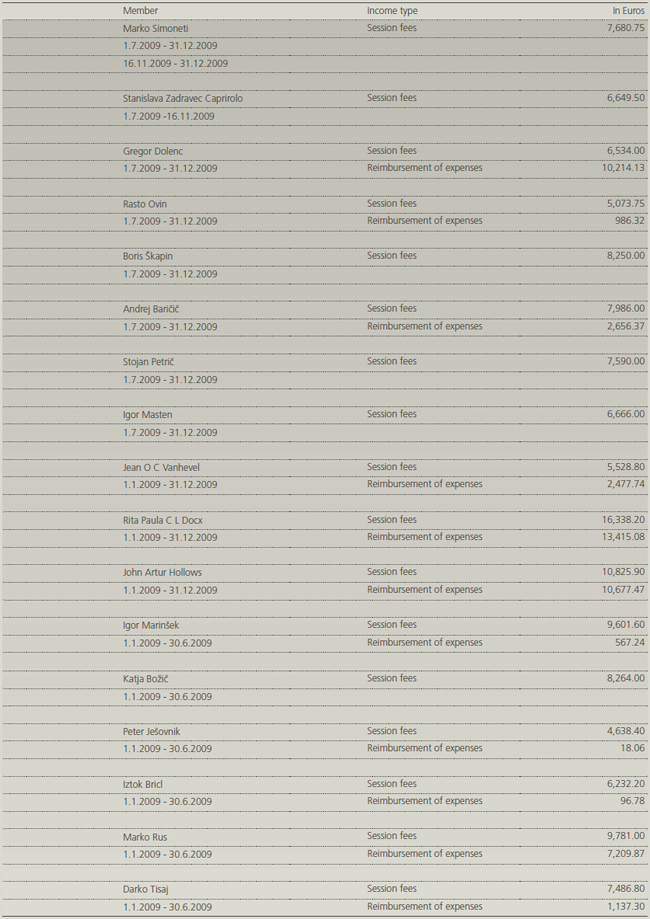
Annual Report 2009